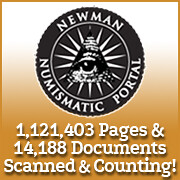
About UsThe Numismatic Bibliomania Society is a non-profit organization devoted to the study and enjoyment of numismatic literature. For more information please see our web site at coinbooks.org SubscriptionsThose wishing to become new E-Sylum subscribers (or wishing to Unsubscribe) can go to the following web page link MembershipThere is a membership application available on the web site Membership Application To join, print the application and return it with your check to the address printed on the application. Print/Digital membership is $40 to addresses in the U.S., and $60 elsewhere. A digital-only membership is available for $25. For those without web access, write to: Terry White, Treasurer AsylumFor Asylum mailing address changes and other membership questions, contact Terry at this email address: terrywhite5475@yahoo.com SubmissionsTo submit items for publication in The E-Sylum, just Reply to this message, or write to the Editor at this address: whomren@gmail.com BUY THE BOOK BEFORE THE COINSale Calendar |
- WAYNE'S WORDS: THE E-SYLUM AUGUST 13, 2017
- NEW BOOK: CHARLTON CANADIAN COINS 71ST EDITION
- NEW BOOK: COIN HOARDS OF THE BENGAL SULTANS
- THE COLONIAL NEWSLETTER AUGUST 2017
- BOOK REVIEW: MONEY TALKS: BRITISH MONARCHS
- BOOK: SCHOOLCHILD CERTIFICATES AND MEDALS
- COUNTERFEITING AND TECHNOLOGY WINS NLG AWARD
- JON P. AMATO, PH.D. (1940-2017)
- JOHN FEIGENBAUM REMEMBERS LEON HENDRICKSON
- A NUMISMATIC CELEBRATION OF THE TOTAL ECLIPSE
- PLANNING FOR DIGITAL OBSOLESCENCE
- ROME SYMPOSIUM ON ISLAMIC COINAGE
- THE MAKING OF A WIKIPEDIA ARTICLE
- NOTES FROM E-SYLUM READERS: AUGUST 13, 2017
- ARTICLE PROFILES JODY CLARK OF ROYAL MINT
- GOLINO INTERVIEWS MINT SCULPTOR DON EVERHART
- DENNIS TUCKER'S FAVORITE DON EVERHART DESIGNS
- TOM BABINSZKI INTERVIEWS THE NUMISMATOURIST
- VOCABULARY TERM: LIMITED EDITION
- MYRON XENOS (1938-PRESENT)
- DISPLAYING THE JOSIAH K. LILLY COLLECTION
- DAVE PERKINS' 2017 JRCS ANA SHOW REPORT
- JOINED HALVES COUNTERFEIT 1889-CC MORGAN DOLLAR
- BRIDGES TO NEWER GENERATIONS OF COLLECTORS
- NUMISMATIC NUGGETS: AUGUST 13, 2017
- ON BIBLIOKLEPTOMANIA
- KELLEN HOARD'S 2017 DENVER ANA DIARY
- DETECTORIST UNCOVERS ROMAN HACKSILVER HOARD
- ENGLISH STACKING WEIGHTS WITH U.S. COPPERS
- FOR THE LOVE OF MONEY EXHIBIT COMES TO MOAF
- LORD ASHCROFT ON CAPTAIN ACKROYD'S MEDALS
- ROYAL MINT MUSEUM OF HYDERABAD PROPOSED
- SCOTLAND'S NEW MARY SOMERVILLE POLYMER £10 NOTE
- BRITAIN TO CONTINUE POLYMER WITH TALLOW
- GOING CASHLESS IN ROCHESTER, NY
- PANHANDLER’S LAMENT: NO ONE HAS CASH TO GIVE
Click here to access the complete archive
To comment or submit articles, reply to whomren@gmail.com
Content presented in The E-Sylum is not necessarily researched or independently fact-checked, and views expressed do not necessarily represent those of the Numismatic Bibliomania Society.
WAYNE'S WORDS: THE E-SYLUM AUGUST 13, 2017
This week we open with two new books, a new periodical issue and one book review. Other topics this week include Leon Hendrickson, Jon Amato, Wikipedia, Royal Mint artist Jody Clark, U.S. Mint artist Don Everhart, Myron Xenos, stacking coin weights, Roman hacksilver, and little pointy beards on coins.
To learn more about African-Americans at the Connecticut mint, numismatics of the total eclipse, digital obsolescence, King Rama V, Rev. Justus Doolittle, the Numismatourist, the Bearded Goddess, the Banksy Di-faced Tenner, bibliokleptomania and the Panhandler’s Lament, read on. Have a great week, everyone!
Wayne Homren
Editor, The E-Sylum
NEW BOOK: CHARLTON CANADIAN COINS 71ST EDITION
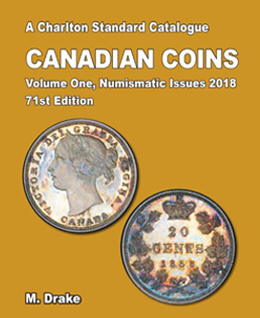 2018 Charlton Vol 1 - 71st Ed
2018 Charlton Vol 1 - 71st Ed
71st Edition
Editor: Mark Drake
Price: CDN $24.95 US $22.95 UK £0.00
Release Date: July 2017
294 pages
Dimensions: 7 x 9
ISBN: 9780889684034
First published in 1952 The Charlton Standard Catalogue of Canadian Coins has reported on all aspects of the Canadian numismatic scene, from the coinage of the French Regime to the business strikes of today. For more than 60 years Canadian Coins has been the bible for collectors. Emphasis in Volume One is on business strikes and commemorative issues struck for circulation, varieties. and all legal tender coinage issued from 1858 to date. Each chapter has been updated and revised to bring it current to 2018. Within the circulating coinage of Canada variety listings each denomination has been reviewed, corrected and expanded. All newly gathered technical information, listings and pricing were incorporated into this new release of Canadian Coins. Volume One, Numismatic issues.
For more information, or to order, see:
2018 Charlton Vol 1 - 71st Ed (http://www.charltonpress.com/NumismaticsBook.asp?v_ISBN=9780889684034)
NEW BOOK: COIN HOARDS OF THE BENGAL SULTANS
 Authors (s): Sutapa Sinha (Author)
Authors (s): Sutapa Sinha (Author)
Format: Hardcover
ISBN-13: 9788182904088
Pages: 232p., Illustrations; 243 Figure; 28cm.
Pub. date: 22.07.2017, 1st. ed.
Publisher: Shubhi Publications
Language (s): English
Bagchee ID: BB109061 vList price: US $ 170,00
Bagchee price: US $ 153,00
The book embodies the critical analysis of forty-one major coin hoards and fifteen minor finds of the Bengal Sultans recovered from a vast geographical region, comprsing pre-partition Bengal, Bihar, Jharkhand and Assam. The hoards discussed in the book consist mainly of coins of the Bengal Sultans but there are also coins of Delhi Sultans with a few sporadic specimens of the Bahamanis and the Sharqi Sultans in some hoards. Coins of the Suri Sultans and Mughal Emperor Akbar are also present in some others along with considerable number of specimen of Hindu rulers of Eastern India like the Kings of Koch Bihar and Tripira. The Corpus will thus help from an idea of the coinage and monetary system of Eastern India during the 13th-16th centuries CE. The data base of this book also offer scope for future research on socio-economic condition of medieval Bengal vis-a vis the contemporary sultanates and on the diplomatic relations of Bengal with the Kamrup and Kamta region during the some period.
To read the complete article, see:
Coin Hoards of the Bengal Sultans 1205 - 1576 AD:
From West Bengal, Bihar, Jharkhand, Assam and Bangladesh
(http://www.bagchee.com/books/BB109061/coin-hoards-of-the-bengal-sultans-1205-1576-ad-from-west-bengal-bihar-jharkhand-assam-and-bangladesh)
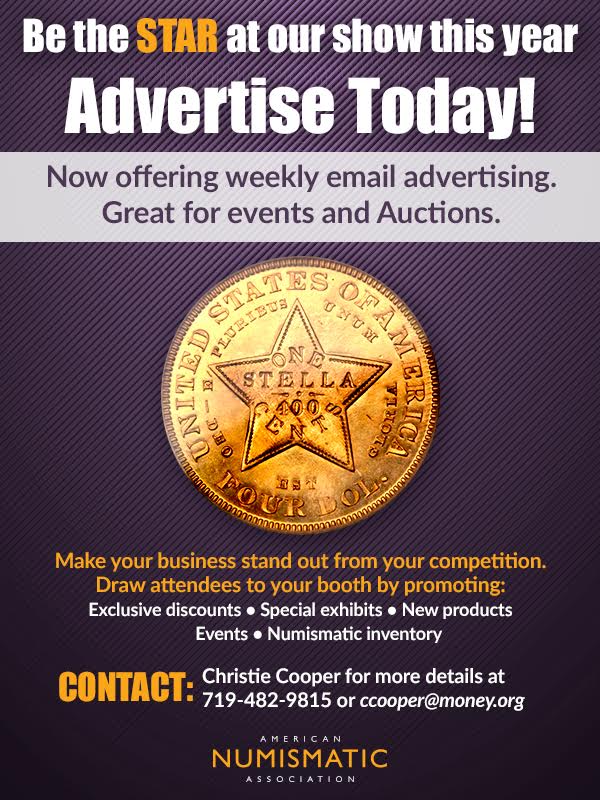
THE COLONIAL NEWSLETTER AUGUST 2017
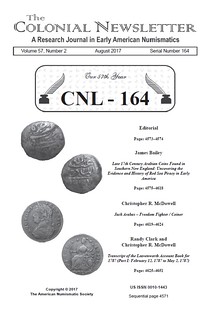 Issue 164 of the Colonial Newsletter will be delivered to subscribers in August. This issue is very large and contains the first half of the 1787 Connecticut Mint transcripts – this
document is actually Mark Leavenworth’s daily ledger book.
Issue 164 of the Colonial Newsletter will be delivered to subscribers in August. This issue is very large and contains the first half of the 1787 Connecticut Mint transcripts – this
document is actually Mark Leavenworth’s daily ledger book.
Randy Clark and I, along with teams of assistants, have transcribed all of the entries for 1787, which is the period when Mark Leavenworth maintained an ownership interest in the Connecticut mint. The ledger reveals, among other interesting discoveries, that blanks for Connecticut coppers were processed at a mill in Hamden, Connecticut, and transported the short distance to Leavenworth’s store in New Haven where they were struck on a press at his shop.
There were, in my opinion, multiple presses in New Haven striking Connecticut coppers in 1787, with at least one other press located at Abel Buell’s shop. This transcript, along with the transcript of the 1788 records, is essential reading for anyone interested in the history of the Connecticut mint. We will be publishing the rest of the 1787 records in Issue 165 of CNL.
The current issue also contains a lengthy article outlining the discovery of Arabic coins in New England that circulated in Colonial America for a brief period. The author has detailed a number of finds of these coins and presents his theory on how they arrived in the American colonies in the 1690s.
The final article is a short piece by me on Jack Arabas, who was an employee of the Connecticut mint. Jack, who was born into slavery, is one of history’s unsung heroes as he is responsible for delivering hundreds of men from bondage. This article details what is known of Jack’s life and his interaction with the owners of the mint and is the second article I have published this year recounting the stories of African-Americans, both free and slave, who worked at the Connecticut mint.
BOOK REVIEW: MONEY TALKS: BRITISH MONARCHS
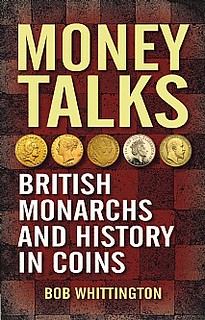 It is hard to talk about coin collecting without understanding the history that surrounds coins. Often, the way it happens is that we know about certain facts of history, and when we get a
coin from the same age and location, we can put it into perspective. Or, we can take the other approach. Take a random coin, and examine the era and the country the coin is from. They are both
interesting, but time consuming approaches. We either have to hunt for particular coins, or read up on the background of a coin.
It is hard to talk about coin collecting without understanding the history that surrounds coins. Often, the way it happens is that we know about certain facts of history, and when we get a
coin from the same age and location, we can put it into perspective. Or, we can take the other approach. Take a random coin, and examine the era and the country the coin is from. They are both
interesting, but time consuming approaches. We either have to hunt for particular coins, or read up on the background of a coin.
When it comes to the British Isles, Bob Whittington takes the guessing work out of the process, and helps us obtain the information we are looking for much faster, so we can enjoy the coins and the history together.
His book, Money Talks : British Monarchs and History in Coins, is the perfect companion for a coin collector.
Talking about the British monarchs and coins is an impressive endeavor, however, the first surprise is that Bob goes much further, and discusses coinage of the British Isles from the very beginning, 2500 years ago, when Celtic coins were used. The entire first chapter is devoted to the iron age.
The book truly covers history, starting 2500 years ago, until today. The last references are from 2016, and the book was published in 2017.
I was delighted to find that it is not just a story the author perceives it, but he also uses over a hundred references throughout the book, which makes it not only a well-researched book, but provides the reader with a wealth of related resources to browse.
It is the kind of history book I wish I had at school when I started collecting coins. Primarily, it is not a story of coins. Rather, a history of the British Isles as reflected on coins. This makes history so much more interesting for the collector. Well, it is for the collector.
There are some amazing facts from the era of the early kings. Edgar I. introduced the first national currency, which was the start of the establishment of 40 mints which were producing the same types of penny coins. A few years later, under Henry I. we can learn where the expression of “keeping tally” came from, and how it can be considered as an early form of the credit card. In the meantime, I learned that this expression has been known to originate from other sources as well, nevertheless, this story is interesting.
Often blood sticks to money, and under Henry I., some moneyers were even castrated. Not the kind of punishment one would imagine for creating underweight coins.
And just a word about the publisher: Whittles Publishing offered the book to me in an electronic format, so I could immediately start reading so I didn’t have to scan it page by page. I was truly impressed.
You can order the book from Amazon, Nbn Books, Barnes and Noble, etc.
To read the complete article, see:
Book review – Money Talks : British Monarchs and History in Coins
(http://blindcoincollector.com/2017/07/31/book-review-money-talks-british-monarchs-and-history-in-coins/)
To read the earlier E-Sylum article, see:
NEW BOOK: MONEY TALKS (http://www.coinbooks.org/v20/esylum_v20n30a05.html)

BOOK: SCHOOLCHILD CERTIFICATES AND MEDALS

Referred to as rewards of merit, several hundred examples of these tokens of students' progress and teachers' approval are part of the Dr. Richard Lodish American School Collection, and I have had the opportunity to work with many of them—especially those from the mid-to-late 19th century. While some rewards of merit are medallions and pins, most of these rewards are small pieces of paper with either hand-drawn or printed decoration. Some are elaborately ornamented with illustrations and color, while others are simpler, with only the words "Reward of Merit" and the student's name. While the styles vary, each reward had an important meaning for the student: the recognition of a teacher, approval of parents, and establishment among peers.
To read the complete article, see:
Merited behavior: Rewarding the 19th century schoolchild (http://americanhistory.si.edu/blog/merited-behavior)
John Sallay of Boston, MA writes:
I had helped put together the 1994 book mentioned in this blog post, “Rewards of Merit” by Patricia Fenn and Alfred P. Malpa. Al Malpa is a friend who collected mostly paper rewards of merit, so I helped him with the medals part, both the information and the photos. All of the medals (except for one, from Pat Fenn’s family) in that book are in my collection. At the time, it was half mine and half Al’s (with most of those from Rocky Gardiner’s collection), but I bought all of his medals not too long after the book was published.
Dave Bowers helped me arrange for Cathy Dumont to take the photos, so she and I spent an afternoon in the basement of the Bank of Boston building in downtown Boston, where I had a safe deposit box, doing the photography. I learned a LOT about medal photography that day.
 REWARDS OF MERIT. TOKENS OF A CHILD'S PROGRESS AND A TEACHER'S ESTEEM...
REWARDS OF MERIT. TOKENS OF A CHILD'S PROGRESS AND A TEACHER'S ESTEEM...
FENN, Patricia and Alfred P. Malpa.
Ephemera Society of America, (1994),
First Edition. oblong quarto, cloth in dust jacket. 224pp. Ephemera Society of America, Item #11632
"Rewards of Merit are significant documents that illustrate attitudes toward religion, education, and achievement: values with which young Americans were inculcated...This book also demonstrates how evolving methods of the American printing arts have been reflected in every aspect of the production of Rewards of Merit...these examples of folk art and calligraphy, nineteenth-century printing through twentieth-century computer graphics, have affected children, parents, teachers..." Profusely illustrated in color, with hundreds of images. With a detailed index and a useful "Directory of Booksellers, Engravers, Printers, Publishers, Stationers and related tradesmen who were involved in the design, production and distribution of Rewards of Merit in the United States."
For more information, or to order, see:
REWARDS OF MERIT. TOKENS OF A CHILD'S
PROGRESS AND A TEACHER'S ESTEEM... (https://www.colophonbooks.com/pages/books/11632/patricia-fenn-alfred-p-malpa/rewards-of-merit-tokens-of-a-childs-progress-and-a-teachers-esteem)
COUNTERFEITING AND TECHNOLOGY WINS NLG AWARD
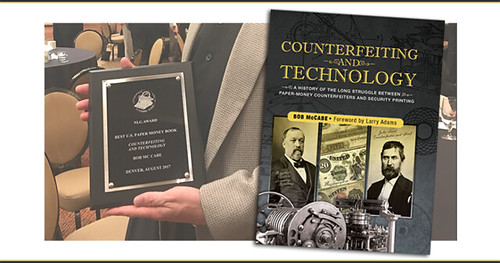
[A]t the World’s Fair of Money in Denver, Whitman author Bob McCabe won the Numismatic Literary Guild’s “Best Specialized Book” award for Counterfeiting and Technology: A History of the Long Struggle between Paper-Money Counterfeiters and Security Printing. The book was entered in the U.S. Paper Money category (which, incidentally, was won the previous year by another Whitman author, Q. David Bowers).
The author was unable to attend, so Whitman publisher Dennis Tucker accepted the award on his behalf.
Counterfeiting and Technology delves back in history to the first known printing of paper money (which took place during China’s Tang dynasty) and follows the technology’s journey from East to West. It balances a study of the chemistries and inner workings of printing with tales of daring heists, escapes, and manhunts as the battle between counterfeiters and authorities grew more and more complex with the technology at hand. (Click here for a detailed review of the book.)
The awards ceremony, emceed by Scott Travers, was part of the Numismatic Literary Guild‘s annual bash, which took place at 8 p.m. in the Sheraton’s Plaza Ballroom.
To read the complete article, see:
Bob McCabe’s Counterfeiting and Technology wins Numismatic Literary Guild
award (http://news.coinupdate.com/bob-mccabes-counterfeiting-and-technology-wins-numismatic-literary-guild-award/)
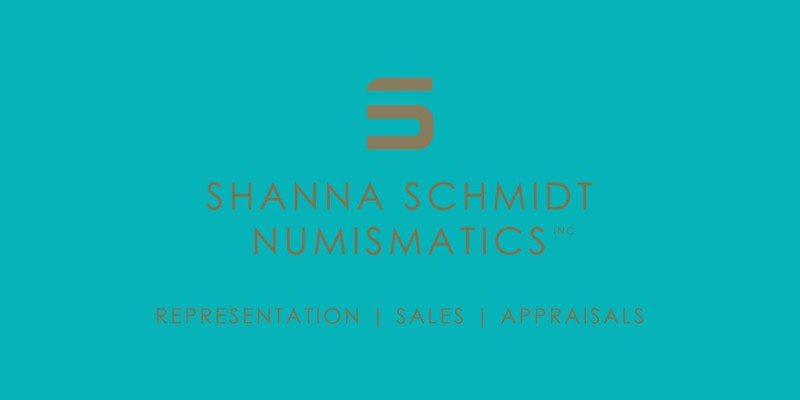
JON P. AMATO, PH.D. (1940-2017)
Mark Borckardt writes:
Last Thursday evening, I picked up an NLG award for semi-retired Heritage cataloger Jon Amato for his background and census of 1802 half dimes. That same day he was admitted to hospice and passed away Saturday morning.
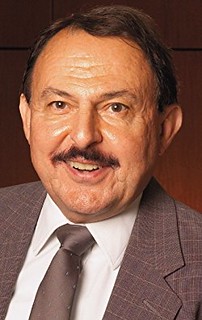 Jon P. Amato was born in New York in 1940 and studied in the United States and Canada, earning his bachelor’s degree from Arizona State University, his master’s degree from the State
University of New York at Buffalo, and his doctorate degree in economic geography from the University of Toronto.
Jon P. Amato was born in New York in 1940 and studied in the United States and Canada, earning his bachelor’s degree from Arizona State University, his master’s degree from the State
University of New York at Buffalo, and his doctorate degree in economic geography from the University of Toronto.
He served for 20 years as a professor in the departments of Geography and Planning at Buffalo State College and the State University of New York at Albany. His professional publications included works on environmental analysis, agricultural location theory, and regional land use planning. He worked for 12 years as a professional economic developer for the states of Arizona and New York. He provided technical assistance to rural Arizona communities, and assisted several New York communities in their efforts toward economic revitalization.
A long-time coin collector who joined the American Numismatic Association in 1981, Amato joined the numismatic cataloging staff of Heritage Auctions after he retired from his position with the State of New York. He returned to his long-time home in Albany, New York in 2010, and continued as a part-time Heritage cataloger, working on nearly every catalog for the past seven years. He recently began researching 1796 quarters with plans to publish a background and census of that issue. The Heritage cataloging staff plans to continue that research project in his memory.
His numismatic works include: “An Analysis of 1796-97 Draped Bust Half Dollars,” The Numismatist, September 2001.
“Surviving 1796-97 Draped Bust Half Dollars and Their Grade Distribution,” John Reich Journal, February 2005.
The Coinage of Augustus Saint-Gaudens as Illustrated by the Philip H. Morse Collection, with James L. Halperin, Mark Van Winkle, and Gregory Rohan (Numismatic Literary Guild Extraordinary Merit Award, August 2007).
“Jules Reiver’s 1796-97 Draped Bust Half Dollar Varieties,” John Reich Journal, April 2007.
“The Bayside New York Collection of 1796-1797 Half Dollar Varieties,” John Reich Journal, November 2008.
“Breakup of the 1796-97 Half Dollar Reverse A,” John Reich Journal, May 2012.
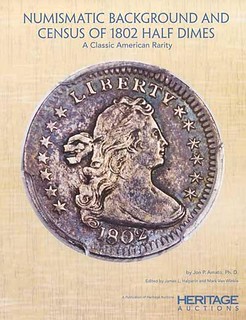 “American Indian Treaty Payments,” The Numismatist, November 2010 (Numismatic Literary Guild Large Club Publications Best Article Award, August 2011).
“American Indian Treaty Payments,” The Numismatist, November 2010 (Numismatic Literary Guild Large Club Publications Best Article Award, August 2011).
The Draped Bust Half Dollars of 1796-1797: Numismatic Background and Census, James L. Halperin and Mark Van Winkle, editors, 2012 (Numismatic Literary Guild Extraordinary Merit Award, August 2013).
Numismatic Background and Census of 1802 Half Dimes: A Classic American Rarity, 2017 (Numismatic Literary Guild Extraordinary Merit Award, August 2017).
To read the earlier E-Sylum article, see:
NEW BOOK: 1802 HALF DIMES (http://www.coinbooks.org/v20/esylum_v20n20a02.html)
JOHN FEIGENBAUM REMEMBERS LEON HENDRICKSON
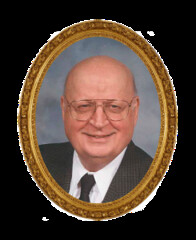 The entire CDN family wishes to express their sincere Condolences to the Family of Leon Hendrickson. Leon, as we all knew him, was a giant in the world of numismatics, yet casual in his
dealings. I never once heard him referred to as “Mr. Hendrickson.” As the founder of SilverTowne, a large Indiana-based mail order and bricks-and-mortar coin shop, Leon was a professional numismatist
for more than half a century. Over that time he successfully navigated his large company during seismic shifts in the coin industry, with a patented charm and class that was beloved by nearly all of
those who knew him.
The entire CDN family wishes to express their sincere Condolences to the Family of Leon Hendrickson. Leon, as we all knew him, was a giant in the world of numismatics, yet casual in his
dealings. I never once heard him referred to as “Mr. Hendrickson.” As the founder of SilverTowne, a large Indiana-based mail order and bricks-and-mortar coin shop, Leon was a professional numismatist
for more than half a century. Over that time he successfully navigated his large company during seismic shifts in the coin industry, with a patented charm and class that was beloved by nearly all of
those who knew him.
I personally had many dealings with Leon as a professional coin dealer. One especially impactful deal that I specifically remember was at a Central States show back in the 1990s where I had just purchased an incredible group of (12) Proof 1895 Morgan dollars graded 63-65 for nearly half a million dollars. It was the most money I’d ever spent on a single purchase at that time and I was more than a little nervous about my new ‘position’ in these coins.
I already knew Leon for some years as a someone my father respected greatly but I thought he was a specialist in less expensive coins so I didn’t think of him first. I spoke to a few dealers at first about my fresh deal but they were scared off by the quantity of coins coming for sale at once. Needless to say I became more nervous. My shoulders slumped, I paced up the aisle wondering about my next move when I saw Leon who was—in a rare moment— available and he waived hello to me. I said, with my biggest smile, “Leon, have I got a deal for you!” (His love of Morgan dollars was no secret.)
Even though the show was lifeless he perked up and inquired what I could possibly have. I think he would have enjoyed looking at VG 1881-S Morgans as much as the 1895’s. He just loved them. Anyway, I showed Leon my loot, and he instantly became as excited about the deal as I had originally been. Leon happily bought 7 of the coins from me with a check I could deposit the following day, which energized me in ways I cannot describe (as I still had 30 days to pay!). He gave me the courage to do more deals like that in the future and not fear a few negative responses from the naysayers. This was a huge lesson for me as a young coin dealer that I will never forget. Leon, may you rest in peace my friend.
To read the earlier E-Sylum article, see:
LEON HENDRICKSON (1926-2017) (http://www.coinbooks.org/v20/esylum_v20n31a12.html)
To read the complete article, see:
GREYSHEET: REMEMBERING LEON HENDRICKSON (1926-2017)
(http://blog.greysheet.com/greysheet-remembering-leon-hendrickson-1926-2017/)

A NUMISMATIC CELEBRATION OF THE TOTAL ECLIPSE
A search of the Newman Portal reveals a few numismatic references to the total eclipse of the Sun. There are quite a few (not all listed here), and a numismatist with an astronomical bent could form an interesting collection of such pieces. Coincidentally, the August 21st eclipse will be in near totality in St. Louis, home of the Newman Portal at Washington University.
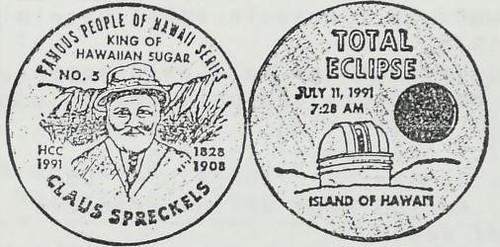
Bunyan’s Chips, the newsletter of the International Organization of Wooden Money Collectors, in November 1991 presented a wooden nickel from the Hawaii Coin Club featuring Claus Spreckels, the 19th century “King of Sugar.” The reverse was a tribute to the total eclipse appearing in Hawaii on July 11, 1991.
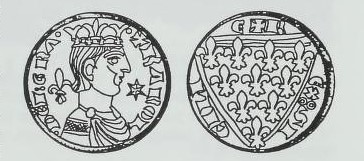
The Missouri Journal of Numismatics, July 1995, includes an article from Marshall Faintich discussing the coinage of Charles I (1227-1285) of Sicily. Faintich suggests that the star to the right of the bust on this reale d’oro signifies the 1267 total eclipse, thought to be a divine endorsement of Charles’ I occupation beginning in 1266.
The excellent Forrer biographical dictionary of medallists notes a wax medallion depicting the solar eclipse by engraver Jean Martin Renaud (b. 1746).
Thomas Elder’s 66th sale (September 1912) describes lot 723, part of a collection of medals related to Martin Luther:
Solar eclipse of 1706. Square medal. Obv. View of the total eclipse (ie. Roman power) with dates of introduction of the Reformation in Brabant, Madrid, etc. Rev. the Sun (i.e. Lutheranism) emerging with rays, and inscription. 55 mill.
The New Netherlands sale of December 1940, lot 1450, listed this medal from Aix-la-Chapelle:
1748. Medal on the Solar Eclipse. View of sun with moon passing in front. Rev. Sun with Dove of Peace shining on Europe below. 37 mm.
Link to November, 1991 issue of Bunyan’s Chips
https://nnp.wustl.edu/library/book/521372?page=76
Link to 1995 Missouri Journal of Numismatics:
https://nnp.wustl.edu/library/book/512212?page=4
Link to Biographical Dictionary of Medallists:
https://nnp.wustl.edu/library/books?searchLetter=B
Link to Thomas Elder’s 66th sale:
https://nnp.wustl.edu/library/auctionlots?AucCoId=23&AuctionId=511500&page=41
Link to New Netherlands’ December 1940 sale:
https://nnp.wustl.edu/library/auctionlots?AucCoId=27&AuctionId=515050&page=62
PLANNING FOR DIGITAL OBSOLESCENCE
 If you’ve happened to glance through an old family album, it is likely you’ve found photographs still around from over a century ago. Perhaps, too, you’ve found old letters your
grandparents wrote one another or an old ticket stub to the movies.
If you’ve happened to glance through an old family album, it is likely you’ve found photographs still around from over a century ago. Perhaps, too, you’ve found old letters your
grandparents wrote one another or an old ticket stub to the movies.
These artifacts help build a more complete story of the lives of those from yesteryear. Those stories are important on a personal and institutional level when it comes to collective memory.
Which begs the question: what will happen to memories created in this era, the majority of which are stored in digital file formats? What will happen if files like mp3s, jpegs, gifs, tweets, Facebook posts and Word documents are no longer readable? Or the hardware to read such files is hard to access, as is the case with VHS tapes or LaserDisc?
On Wednesday’s St. Louis on the Air, we discussed the idea of “digital obsolescence” and how librarians, archivists and digital media managers are tackling the problem. They also offer some ideas on how you can be sure your memories are accessible for the future that lies ahead.
The first rule of digital preservation? "Replication. Redundancy. Planned migration," said Chris Martinez, the manager of media archives and digital assets for the Missouri History Museum.
That means, create several version of the thing you want to save, keep the file in multiple places and remember to move files before the way of accessing the file becomes obsolete.
"I think we are all going to become archivists and digital asset managers in the future," Martinez said.

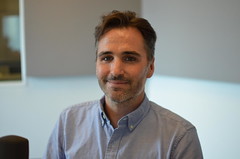
Martinez and Manley
Martinez joined the program alongside Robert Manley, the digital asset coordinator for Archives and Special Collections at Washington University, and Vernon Mitchell, the administrative lead for DocNow, the Andrew W. Mellon Foundation-funded project to archive and preserve 12 million tweets and social media posts from the Ferguson protests. Mitchell is based at Washington University, where he serves as the curator of popular and American arts for the Washington University Libraries.
To read the complete article, see:
In 100 years, will today's digital files be accessible?
Planning for 'digital obsolescence' (http://news.stlpublicradio.org/post/100-years-will-todays-digital-files-be-accessible-planning-digital-obsolescence#stream/0)
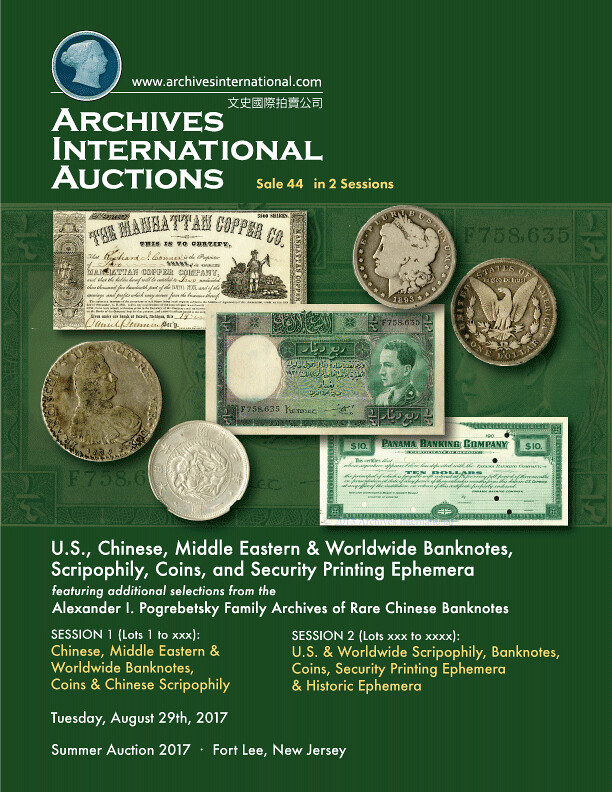
ROME SYMPOSIUM ON ISLAMIC COINAGE

In recent years, Islamic numismatics has known a renewed vitality, due to the publication of corpora, collection catalogues, essays on the chronology of mint-output and mint activity (see the Survey of Numismatic Research presented at the occasion of the XV International Numismatic Congress in Taormina, but also the review by Arianna D’Ottone Rambach that has appeared in Comunicazione).
However, coin finds and hoards from archaeological contexts are one of the aspects least studied in the field of Islamic numismatics. Whilst it is a well-established trend of research in Ancient and Medieval numismatics, the study and the analysis of the function of Islamic coins in archaeological contexts deserve more attention. Therefore, the theme to which the next edition of the Simone Assemani Symposium will be dedicated is: “Islamic coins in archaeological context: coin finds, coin circulation”. Themes of research linked to this topic include: Islamic coins in archaeological excavations; Coin use and coin circulation; Mint production and coin circulation; Coin hoards; Mints and monetary areas.
As usual, a special panel will be devoted to new researches about Assemani. This panel is entitled Assemani and his cultural environment: contacts, correspondents and letters.
Moreover since the interest of letters between numismatists, as a valuable source for the history of the discipline, has been highlighted by the project Fontes Inediti Numismaticae Antiquae (FINA) – devoted to Classical numismatics until 1800, there is the need to develop a parallel project: Fontes Inediti Numismaticae Orientalis (FINO). Therefore a special session of the 5th Simone Assemani Symposium will welcome contributions dedicated to manuscripts (letters and codices), to the reception of printed book, to networks of collectors, to the history of Oriental collections in European coin cabinets, and to the perception of Oriental coins in Europe.
The conference will take place in Rome, at the Museo Nazionale Romano (Friday 29 September 2017) and at Sapienza University (Saturday 30 September 2017).
Lectures will include talks by:
- Marco Callegari on A bibliographical (and not just) correspondence: letters of Simone Assemani to Giovanni Bernardo De Rossi (1788-1814)
- Arianna D’Ottone Rambach on Un’inedita traduzione di Simone Assemani nell’archivio dell’Eremo di Camaldoli (Arezzo) Khadijeh Baseri on Islamic Coins
- Michael Bates on The two Mithqals and the weight standard of the Islamic Dinar
- Lutz Ilisch on Methodological problems in the comparative analysis of hoards with fragmented coins
- Alaa Aldin Alchomari on Les monnaies individuelles dans les sites archéologiques syriens
- Hassan Al-Akra on The history of Baalbak in Medieval Era through the coins (AD 636-1516)
- Rowida Rafaat Al-Nabarawy on A rare Samanid Dinar struck in Muhammadiyya in 341 A.H. bearing the names of Prince Noah b. Nasser and the Caliph al-Mustakfī billah
- Andrea Gariboldi on Numismatic finds from Kafir Kala as evidence of the Islamic transition in Samarkand
- Antonino Crisà on Why should the state keep Arabic coins? Assessing two case studies on nineteenth century Sicily
- Fiorentino Pietro Giovino on Sul ritrovamento di una matrice sigillare islamica a Lagopesole: un contributo quasi inedito di Michele Amari
- Stefania Santangelo on Paolo Orsi e la monetazione araba di Sicilia nel Medagliere di Siracusa: documenti d’archivio
- Robert Kool on The large Fatimid gold hoard from Caesarea Maritima harbor (2015): preliminary results and conclusions
- Carolina Doménech-Beda on The Fatimid coins from Sicily in al-Andalus: the Jabonerias hoard (Murcia, Spain)
- Andrea Saccocci on Il mancuso nelle fonti medievali: metamorfosi di un mito
- Roman Kovalev on Viking-Rus’ mercenaries in the Byzantine-Arab Syrian wars of the 950s-960s: the numismatic evidence
- Dorota Malarczyk on Oriental coins from early-medieval silver hoard from Kąpiel, Czerniejewo Commune, Greater Poland
- Warren Schultz on Re-excavating the excavated: analyzing Mamluk Dirham hoards from Jordan via field reports and publications
- Irakli Paghava on New data on the Ottoman coinage minted in the Georgian kingdom of Kakheti (the Telavi hoard)
In addition, on Friday 29 October, there will be the formal presentation, with talks by Annliese Nef and Andrea Saccocci, of Arianna D’Ottone Rambach’s new book on the Collezione di Vittorio Emanuele III. Monete Arabe.
THE MAKING OF A WIKIPEDIA ARTICLE
Bob Leonard wrote:
... researchers must never fall into the habit of using secondary information. I suppose that this is elementary and unworthy of notice, but in a day when I see Wikipedia, of all things, being cited as an authority, and some people believing that anything you find on the internet is the equal of an exhaustively-researched and vetted book, maybe it is worth mentioning.
Arthur Shippee of Hamden, CT wrote:
Wikipedia is pretty decent. Its articles are supposed to be well-sourced. My chief concern is more that it is boring rather than wrong. Used properly, it is a solid source.
Paul Schultz of Pennsylvania wrote:
I think some judgement is needed in determining the validity of Wikipedia articles. I would not trust popular and trendy topics without checking other sources. I would have an eye out for statements that don't make sense in the context of what I already know. But if the topic is not a likely subject for those of questionable interests, and the contents indicate the author must have a good academic knowledge of the topic, I have found a substantial number of articles that are valuable and reliable.
Among our newer readers is a Wikipedia author and administrator, who offers some insight into the process of creating these articles. -Editor
Gary Greenbaum of Fairfax, VA writes:
I’ve been reading the discussion of online sources and in particular Wikipedia. I’m possibly the only ANA member to be a Wikipedia administrator, and since I’ve written some of the coin articles on Wikipedia, I thought I’d write in and say a few words.
Since I felt Wikipedia needed better coverage of numismatics, I’ve slowly been improving some of the coin articles, and adding new ones, especially on U.S. commemorative coins. This isn’t happening in any organized fashion, there’s no real central authority for such things. People write about what they’re interested in. I’ve accumulated a decent numismatic library over the years, and now that The Numismatist is online, that’s a help, since the article should be based on sources which the reader can check. In addition to commemoratives, I’ve managed to get enough books on British coins to start improving those articles as well.
I try for something that has information for coin collectors, as well as for people who just discovered a coin and are trying to find more about it. There’s a fairly standardized format that’s evolved: how the coin came to be, a discussion of its design, and what happened to the coin once it was issued. The articles I write tend to get looked at by others, as I bring them to what is called Featured Article Candidates. But since we have few coin collectors, that doesn’t mean that they get seen by people knowledgeable about coins. Sometimes they do, though, I had experts in Shield nickels and also Eisenhower dollars look over those articles at some point.
How can the numismatic community help? One way is if they see errors or the like, to say something. The tab “Talk” on most Wikipedia pages will take you to the talk page, where you can leave a comment. We’re also in fairly desperate need of images, especially of U.S. commemoratives. We’ve been fortunate to get donations of images, even a few from the Smithsonian, but those seem to have run dry. It’s hard to write an article without being able to show decent-quality images. So uploading better quality images would help. But I’m pleased just to have them read.
I can be reached at garymgreenbaum@gmail.com, or on Wikipedia by typing in the search box: User talk: Wehwalt
Ron Haller-Williams writes:
All I can say to Paul (and others) is, "If you see something that's wrong in Wikipedia, CORRECT IT !!!" If you have the knowledge, then Wikipedia depends upon YOU. Until I made a change, it even had my wife's grandfather living over 20 years longer than he actually did. And I've probably made over 80 other changes, many relating to numismatic aspects.
Gary adds:
We can’t use images from other sites unless they’ve been released under a Creative Commons or similar license.
To read the complete articles, see:
Waterloo Medal (Pistrucci) (https://en.wikipedia.org/wiki/Waterloo_Medal_(Pistrucci))
Three-cent nickel (https://en.wikipedia.org/wiki/Three-cent_nickel)
Roosevelt dime (https://en.wikipedia.org/wiki/Roosevelt_dime)
Norse-American medal (https://en.wikipedia.org/wiki/Norse-American_medal)
Oregon Trail Memorial half dollar (https://en.wikipedia.org/wiki/Oregon_Trail_Memorial_half_dollar)
To read the earlier E-Sylum articles, see:
NOTES FROM E-SYLUM READERS: JULY 23, 2017 : Critical Thinking About Internet Sources
(http://www.coinbooks.org/v20/esylum_v20n30a12.html)
NOTES FROM E-SYLUM READERS: JULY 30, 2017 : Wikipedia As an Information Source
(http://www.coinbooks.org/v20/esylum_v20n31a20.html)
NOTES FROM E-SYLUM READERS: AUGUST 6, 2017 : More on Wikipedia As an Information Source
(http://www.coinbooks.org/v20/esylum_v20n32a13.html)
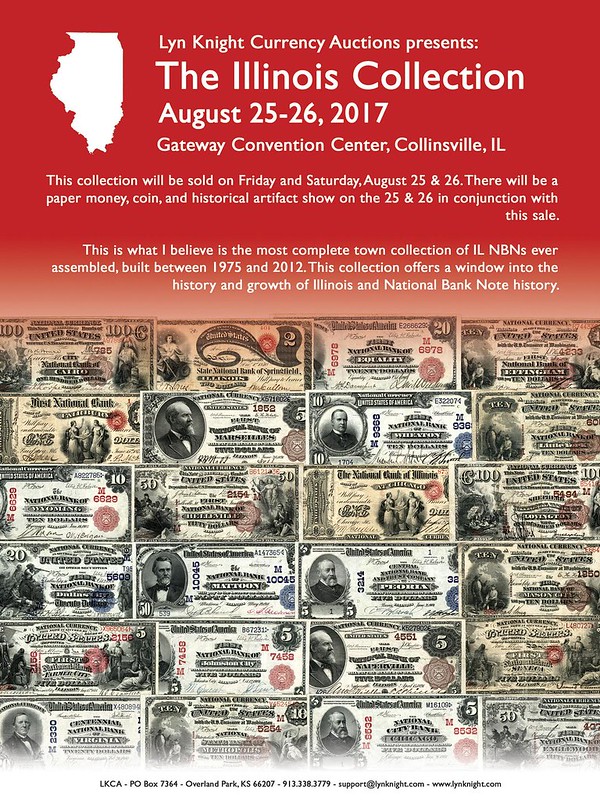
NOTES FROM E-SYLUM READERS: AUGUST 13, 2017
British Historical Medals Book
Robert H. Thompson of London Borough of Harrow writes: 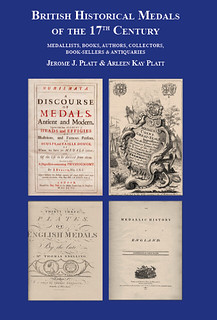
Thanks for news of the Platt & Platt book on British historical medals of the 17th century, which I hastened to buy on Tuesday 8th August. I look forward to reading it.
To read the earlier E-Sylum article, see:
NEW BOOK: BRITISH HISTORICAL MEDALS OF THE 17TH CENTURY (http://www.coinbooks.org/v20/esylum_v20n32a03.html)
John Ward Dunsmore Painting
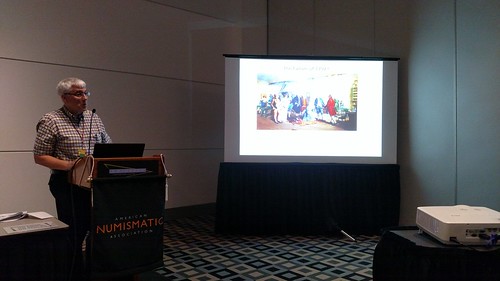
Regarding my Denver ANA show diaries, and my description of a painting in the book 1792: Birth of a Nation's Coinage, Joel Orosz writes:
An amazing report. Just so you know, I did find one minor error, in the caption for the picture of me and the painting--the painting was by John Ward Dunsmore, not by Pete Smith.
To read the earlier E-Sylum article, see:
WAYNE'S NUMISMATIC DIARY: AUGUST 6, 2017, PART 2 : 1792 Presentation (http://www.coinbooks.org/v20/esylum_v20n32a24.html)
Reminder: 2017 CSNS Author Grant Applications Due August 31
Bruce Perdue writes:
As a reminder the Central States Author grant applications must be received by 8/31/2017 for those who are interested in applying.
The grants are for a maximum of $5000. Interested individuals should email Ray Lockwood CSNS Education Director for applications and additional information.
To read the earlier E-Sylum article, see:
CENTRAL STATES AUTHOR GRANT APPLICATIONS (http://www.coinbooks.org/v20/esylum_v20n29a07.html)
More on the 1783 Type II Quint
Last week I discussed viewing the 1783 Type II Nova Constellatio Quint at don Kagin's table at the Denver ANA convention. Bill Burd of Chicago, IL writes:
After purchasing the Quint in 1979 Walter Perschke put it in his safe deposit box where it remained for 32 years. When he decided to bring it out, he discussed it with me and we decided to display it at my booth at the Chicago ANA convention in August of 2011. He produced a color tri-fold which we handed out at my table.
We discussed $1,000,000 insurance for transporting it to the show. We contacted our respective insurance companies, as well as Brinks and a private armed courier service. Nothing seemed to be practical or cost effective. Without telling anyone Walter simply drove to the convention, took the Quint from his pocket at placed it in my showcase.

Bill Burd and Walter Perschke at Bill Burd's table in 2011
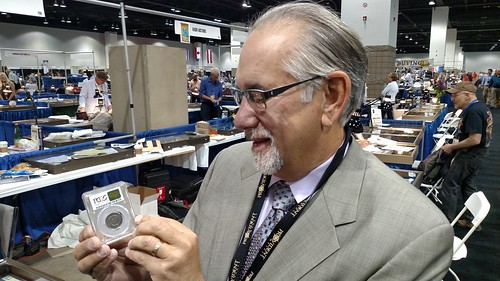
Don Kagin with the coin in 2017
To read the earlier E-Sylum articles, see:
1783 NOVA CONSTELLATIO PATTERN COINS ON DISPLAY AT 2011 CHICAGO ANA (http://www.coinbooks.org/esylum_v14n34a08.html)
WAYNE'S NUMISMATIC DIARY: AUGUST 21, 2011 (http://www.coinbooks.org/esylum_v14n35a13.html)
WAYNE'S NUMISMATIC DIARY: AUGUST 6, 2017, PART 1 (http://www.coinbooks.org/v20/esylum_v20n32a23.html)
Bronze Portrait Plaque of King Rama V
Howard Daniel writes:
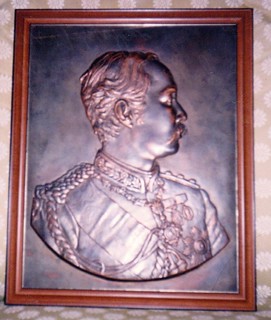 One of my prized possessions is lot 61211 in the upcoming Stacks Bowers Auction in Hong Kong. It is a plaque of Rama V of Siam (Thailand) which was made in Paris after he was visiting there
in 1897. The image was used on many numismatic pieces. Many years ago before a Baltimore ANA, Joe Boling and I were walking through some antiques a dealer had set up in the pre-ANA. We separated to
cover more ground and would yell at each other about something the other might want. One of Joe's yells at me was pointing out the plaque. I almost had a heart attack when I saw it. I brought it
to the seller and asked him what was the price for it. He was surprised that I wanted that old "Chinese" item. He told me his price and I almost tore my wallet in half to get the money out
of it. There are two other plaques known but they are round and mine is only one that is rectangular. Rama V is a very famous and much loved king of Siam. One of his major accomplishments was
eliminating slavery. I told my wife, Phung, about him as I showed her the plaque after returning home. We had it framed in a very nice frame and hung it in our home. When I decided it was time for it
to find a new home, she really did not want to let it go but she finally told me it was OK. Now that I am 75, I need to start downsizing. The plaque has a full page in the catalog and I hope it ends
up in the hands of a numismatist who also appreciates Rama V.
One of my prized possessions is lot 61211 in the upcoming Stacks Bowers Auction in Hong Kong. It is a plaque of Rama V of Siam (Thailand) which was made in Paris after he was visiting there
in 1897. The image was used on many numismatic pieces. Many years ago before a Baltimore ANA, Joe Boling and I were walking through some antiques a dealer had set up in the pre-ANA. We separated to
cover more ground and would yell at each other about something the other might want. One of Joe's yells at me was pointing out the plaque. I almost had a heart attack when I saw it. I brought it
to the seller and asked him what was the price for it. He was surprised that I wanted that old "Chinese" item. He told me his price and I almost tore my wallet in half to get the money out
of it. There are two other plaques known but they are round and mine is only one that is rectangular. Rama V is a very famous and much loved king of Siam. One of his major accomplishments was
eliminating slavery. I told my wife, Phung, about him as I showed her the plaque after returning home. We had it framed in a very nice frame and hung it in our home. When I decided it was time for it
to find a new home, she really did not want to let it go but she finally told me it was OK. Now that I am 75, I need to start downsizing. The plaque has a full page in the catalog and I hope it ends
up in the hands of a numismatist who also appreciates Rama V.
To read the complete lot description, see:
THAILAND. Bronze Portrait Plaque of King Rama V, ND (ca. 1897). (https://auctions.stacksbowers.com/lots/view/3-82ZBE)
Notes From Bruce W. Smith
1) I came across a book on Russian naval medals on Ebay. Never heard of it before, but it is way outside my field of interest. Price is reasonable. The ID# is 332252590525.
To read the complete lot description, see:
Russian IMPERIAL NAVY BADGES & JETTONS 1696-1917 BOOK 1696-1917 photo
catalog@@ (http://www.ebay.com/itm/Russian-IMPERIAL-NAVY-BADGES-JETTONS-1696-1917-BOOK-1696-1917-photo-catalog-/332252590525)
2) Regarding the two St. Louis half dime tokens. The Nicholson token with the scales turns up from time to time on Ebay and in auctions. It is scarce but not rare. There is another variety, however, which is rare. This one has an eagle on the obverse and was once listed in an old Wayte Raymond catalog of US coins as a Confederate States coin! The Wilson token has been for sale on Ebay for the past year at around $300 with no takers.
Chris Bower writes:
In regards to the piece on the Half Dime Token. You had shared my blog in a previous issue. It caught me off guard because I have only seen a few of these and for a moment thought you had re-used the article. It is one of my favorite pieces.
To read the earlier E-Sylum articles, see:
NICHOLSON'S HALF DIME TOKEN (http://www.coinbooks.org/esylum_v19n39a21.html)
THE NICHOLSON AND WILSON HALF DIME TOKENS (http://www.coinbooks.org/v20/esylum_v20n32a20.html)
3) The book on Taiwan tokens is great and is the first catalog on the subject to be published. I have been working on one for years, but it is still a manila file folder in my drawer on Chinese tokens. It is difficult to use because it is arranged by topic -- nine major topics with many subtopics. The rarity scale seems reasonable, though I have some disagreements with his rarity on some U.S. military tokens for Taiwan.
To read the earlier E-Sylum article, see:
NEW BOOK: TAIWAN'S TOKENS (http://www.coinbooks.org/v20/esylum_v20n31a07.html)
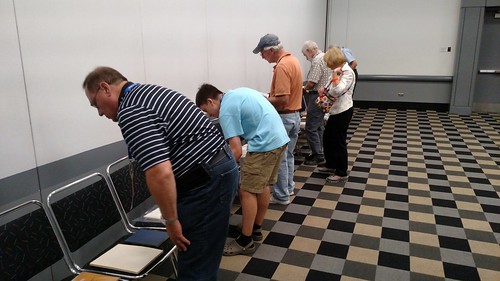
4) The image of the NBS book sale (books on chairs) was amusing. Some people seem to be worshiping them
To read the earlier E-Sylum article, see:
WAYNE'S NUMISMATIC DIARY: AUGUST 6, 2017, PART 2 : NBS General Meeting (http://www.coinbooks.org/v20/esylum_v20n32a24.html)
Imitiation Japanese Oban

Jeff Dickerson writes:
Regarding the mystery Japanese items, I remember seeing similar items in a Hans Schulman sale catalogue. I checked, and the Edward Kann Collection sale of June 18-20, 1971 has plate photos similar to those you've shown (lots 1417-1424). The catalogue description lists these as Japanese "koban", although only the gold type is represented in the listings.
Bruce W. Smith writes:
The oval gold and silver pieces are imitations of Japanese oban or koban (depending on weight) gold coins issued from the 1600's into the 1800's. These were most likely made as souvenirs or store promotions or perhaps made for a collector to give out as gifts. The markings on the back will probably provide the key, but they are too faint to make out.
Kyle Ponterio writes:
These are not legitimate coins issued by the Japanese. These are fantasy issues made for foreigners in the late 1800’s to early 1900’s as they did not want the real coins leaving the country. They come in a plethora of shapes, sizes and denominations with many varieties struck in gold and silver.
None of the reference material either in English or Japanese list these or any of the fantasy issues, but you can occasionally find them in Japanese and foreign auctions. The Japanese list them as fantasy issues while the foreign auctions may list them as genuine items or fantasy issues (It really depends on the auction house and if they really know the series or not).
To read the earlier E-Sylum article, see:
QUERY: MYSTERY JAPANESE ITEMS (http://www.coinbooks.org/v20/esylum_v20n32a11.html)
More on Justus Doolittle
Bruce W. Smith writes:
You mentioned Helen Wang's note on collector Justus Doolittle. He was an American missionary who lived in China from 1850 to 1873, mostly in the area of Foochow (now Fuzhou). His book, "Social Life of the Chinese", contains a wealth of information on Chinese coins and amulets. I have a 1960's reprint of the book, but have never seen the original with Wang Mang spade coin on the spine.
His other book, "Vocabulary and Handbook of the Chinese Language", is also very interesting. I have not seen Volume One, which I imagine is a Chinese-English dictionary, but Volume Two (695 pages) is a collection of miscellaneous information in Chinese and English, arranged in 85 chapters! Chapter 75 is on Chinese coinage and Chapter 79 is on the compradore and shroff. The latter is the employee responsible for examining and testing silver coins received in business, and the one who applied a chopmark to coins found acceptable. Volume Two is available as a print-on-demand reprint.
Doolittle's coin collection is a little more complicated that stated. According to American Journal of Numismatics, July 1866, Doolittle had already sold his collection to B. J. Lake, a Chicago banker, who loaned it to Lake Forest University. In 1872 the collection is said to have passed to Horace Fletcher of San Francisco. Then in June 1881 the collection was cataloged by W. Elliot Woodward and sold by Bangs & Company, consisting of lots 1425 through 1439. When Fletcher bought the collection, it consisted of 464 bronze coins.
Alexander Del Mar (1836-1926) examined the collection and illustrated some of the coins in his "Monograph on the History of Money in China" (1881). This was reprinted in the American Journal of Numismatics in three parts during 1885. Most of the coins are actually forgeries, and my note on Del Mar's monograph reads "A mass of misinformation; totally useless."
Doolittle's diary he kept in China during 1850-1872, is at Hamilton College in Clinton, NY. For some comments on him see page 109 of "Autobiography & Across the Desert of Gobi" by Mark Williams.
To read the earlier E-Sylum article, see:
REV. JUSTUS DOOLITTLE (1824-1880) (http://www.coinbooks.org/v20/esylum_v20n32a18.html)

ARTICLE PROFILES JODY CLARK OF ROYAL MINT
 His initials are on every British coin minted since 2015, but who is the Jiu Jitsu enthusiast who designed the Queen's head, despite never having met her?
His initials are on every British coin minted since 2015, but who is the Jiu Jitsu enthusiast who designed the Queen's head, despite never having met her?
He is an artist whose most famous portrait has been reproduced billions of times, and you probably have one in your pocket right now.
But chances are you never will have heard of Jody Clark. Pull out any British coin minted since 2015 and look carefully enough and there are his initials - beneath the Queen's head.
The quietly-spoken designer's portrait of the Queen was chosen from scores of designs to appear on British coins.
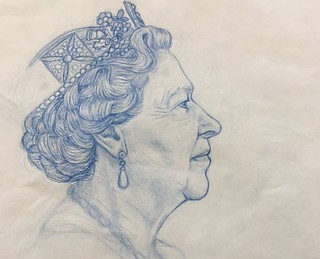 It is only the fifth since she first took to the throne in 1952 and, with the phasing out of the old round pound coin, will soon be the only effigy on £1 coins.
It is only the fifth since she first took to the throne in 1952 and, with the phasing out of the old round pound coin, will soon be the only effigy on £1 coins.
But, as he sits down and swings gently on his office chair at the Royal Mint in Llantrisant, clasping his hands and looking nervous, it is difficult to believe Mr Clark, from Cardiff, is behind the portrait.
The 36-year-old's background in art is a far cry from the classically trained sculptors who have previously modelled the Queen's head for coins.
While his predecessor, Ian Rank-Broadley, trained at the famous Slade School of Fine Art, Mr Clark designed DVD boxes and other packaging after graduating from the University of Central Lancashire.
And rather than focusing on more traditional subjects, Mr Clark, originally from Bowness on Windermere, in the Lake District, has a passion for Jiu Jitsu, which he explores through art.
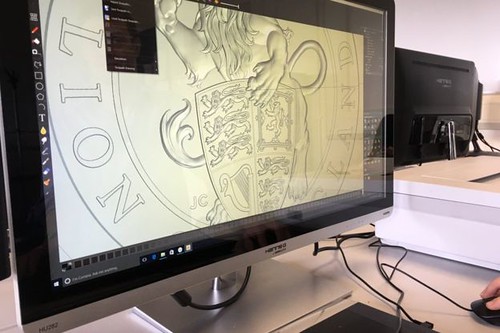
He has drawn pictures of samurai and people in martial art holds, as well as dragons.
But Mr Clark says his past experience of working with packaging and his "obsession" with Jiu Jitsu have helped inspire his coins designs.
He added: "Designing packaging involved embossing - which meant taking account [of] using different thicknesses of material, so in that way it was similar to designing a coin."
To read the complete article, see:
Queen's head: Artist whose initials are on new £1 coin (http://www.bbc.com/news/uk-wales-40801798)
GOLINO INTERVIEWS MINT SCULPTOR DON EVERHART
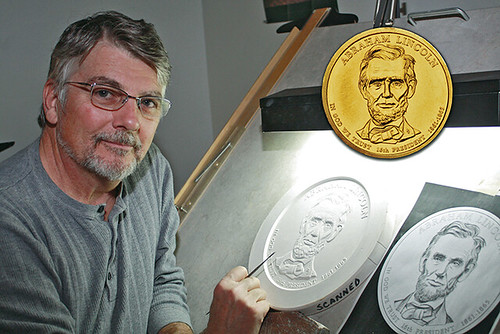
Donald Everhart, a Pennsylvania native who recently retired from the U.S. Mint’s engraving staff after a career that began in 2004, is a prolific artist and medallic sculptor. His work includes designing and sculpting more than 1,000 coins, medals, and other objects over the past four decades. He has received numerous awards for his work, including the American Numismatic Association’s Sculptor of the Year award in 1994. He has said he plans to continue his artistic endeavors working on private commissions.
Mr. Everhart designed or sculpted more than 100 U.S. Mint coins during his tenure working at the Philadelphia Mint, where he rose to become the lead sculptor-engraver. From circulating coins to commemorative coins and Congressional Gold Medals, he has created designs for a wide range of Mint products and often sculpted them, too, and in other cases has sculpted designs prepared by other artists.
While the average person may not know the quarter in their pocket is Mr. Everhart’s work, numismatists and coin collectors who specialize in U.S. coins are well aware of his immense contributions to the field.
Some of the most well-known of his U.S. Mint works include several coins from the State quarter and America the Beautiful quarter series; the concave common reverse of the 2014 Baseball Hall of Fame commemorative coin trio; the reverse of the 2015 March of Dimes silver dollar; the obverse and reverse of the 2016 National Park Service $5 gold coin; the common reverse of the Presidential dollar coins, and many of the obverses; the reverse of the first-term President Obama Mint medal; and both the obverse and reverse of the second-term Obama Mint medal. log.)
His departure from the Mint creates an artistic void that will be difficult to fill. Only four on-staff engravers are left, along with outside artists, like Joel Iskowitz, who are part of the Mint’s Artistic Infusion Program (AIP). At the end of 2016, two other sculptor-engravers retired from the Mint. These shortages, when combined with the hiring freeze imposed on federal government agencies by the Trump administration, means the Mint may need to rely increasingly on outside artists.
Louis Golino: Please describe the process you use to sculpt a coin or medal you designed.
“Once I have my design,” Mr. Everhart replied, “I make a transparency and take a round blank that is eight times larger” than the coin will be, “and add a flat layer of clay that is half of the maximum relief… I then overlay the transparency and use tracing paper” to create an outline of the design, then “remove the paper and have the drawing on the clay.”
The next stage he calls “painting with light” because it creates very strong shadows that are useful for the relief. “Then I add and subtract clay. There is no set process, since it depends on the particular project.” Once the clay model is ready, “I then pour plaster on it and then 45 minutes to an hour later, [after it has dried,] I crack it open using razor blades.” This leaves him with “a negative image of what I have sculpted… Once I am satisfied with the negative image, I do the process all over again” to create a “positive plaster model,” which can be further refined if, for example, it is an architectural design with lots of fine details. “At this point I give it to the person who will create a die” used to mint the coin or medal.
LG: Which artists and sculptors have had a significant impact on your work, whether as part of your training as a painter, or later, when you worked with other artists at various mints?
Mr. Everhart explained that his years at the Franklin Mint, where he began as a layout designer, were when he really learned how to design and sculpt coins and medals. During his lunch, he would go and see what the 38 sculptors were doing.
Renowned artists Gilroy Roberts (the U.S. Mint’s ninth chief engraver, best known for designing the obverse of the John F. Kennedy half dollar) and Philip Nathan (now a British Royal Mint artist, best known for his work on the Britannia series) were two artists then at the Franklin Mint who really had an impact on him. He said that when he compared his own work to Nathan’s at the time, he felt there was a big gap that needed to be addressed.
In addition, several artists from the Brookgreen Gardens (a sculpture garden in South Carolina, which holds workshops where artists such as Heidi Wastweet have given instruction in bas-relief sculpting) and the Art Deco and Art Nouveau styles of art have been inspirations for him.
During his period at the U.S. Mint, he worked closely with former chief engraver John Mercanti. He says he especially enjoyed working with Phoebe Hemphill, whom he referred to as one of the “top-tier sculptors in the country.”
LG: Have you considered writing a book on your work and career, or perhaps putting together a pictorial gallery online?
He said it has been “suggested by several people that he do a book,” but it really depends on whether he is able to get a good offer, adding that he has “a good story to tell.” In addition, fans of his work will be pleased to learn that Mr. Everhart is putting together a website (still in the building stage) that will display his works—both U.S. Mint and other works.
To read the complete article, see:
Donald Everhart: An interview with one of America’s most prolific medallic
sculptors (http://news.coinupdate.com/donald-everhart-an-interview-with-one-of-americas-most-prolific-medallic-sculptors/)
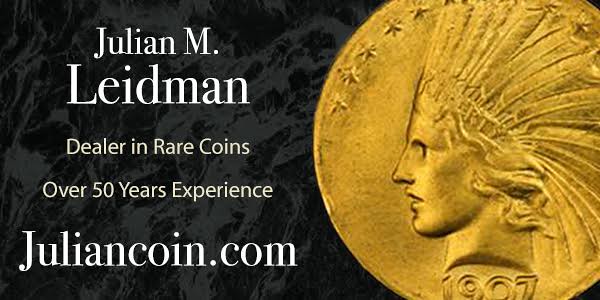
DENNIS TUCKER'S FAVORITE DON EVERHART DESIGNS
If you collect modern U.S. coins, or if you use coins in day-to-day business, you’ve seen and touched the artwork of one of America’s great living sculptors, Don Everhart.
Don joined the staff of sculptor-engravers at the Philadelphia Mint in January 2004, following a career as a designer and sculptor at the Franklin Mint and as a freelance artist creating figurines, plates, coins, medals, and other works for companies such as Walt Disney Co. and Tiffany, and for international mints such as the Royal Norwegian Mint and the British Royal Mint.
I got to know Don in recent years over the course of several visits to the Philadelphia Mint. Whitman Publishing numismatic director Q. David Bowers and I went to Philadelphia to meet the Mint’s engraving staff, tour the production areas, and research in the archives. More recently, since joining the Citizens Coinage Advisory Committee in 2016, I’ve benefited from Don’s expertise as he advised the CCAC on technical and artistic questions.
Don Everhart designed and/or sculpted more than 100 coins and medals for the United States—a remarkable portfolio ranging from State quarters to silver and gold commemoratives and Congressional Gold Medals, among others. This week, in a series of articles for Mint News Blog, I’ll explore some of my favorite Everhart designs, starting with his first U.S. coin, the 2006 State quarter for Nevada.
Nevada State Quarter, 2006
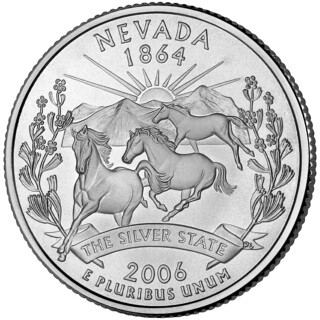
By 2005 the State quarter series was well under way and it included some finely done and nicely balanced designs. But it also included a few that collectors considered bland, cluttered, or even awkward, with state symbols jumbled together in a hodgepodge. The Mint’s artists were somewhat constrained by guidance received by the states’ governors, who decided on motifs and themes based on input from commissions and the public. This led to, for example, Arkansas’ quarter featuring a faceted diamond, marshlands, a flying mallard duck, and stalks of rice. Try putting all of that onto a one-inch canvas!
As he worked on the 2006 Nevada quarter in 2005, Don Everhart had a menu of specific design elements that he had to use: wild horses, sagebrush, the sun rising over the mountains, and the phrase THE SILVER STATE. Artfully combining these elements, he created a tableau that is, in my opinion, one of the most dramatic and effective in the State quarter program. The wild horses, for which Nevada is famous, are shown in energetic motion. The mountains and rising sun are placed in the central background. The mountains are solid and have depth and texture, but they don’t distract from the main scene. Rather they subtly add to its context. Everhart used the sagebrush, another well-known symbol of the American West, to frame the central composition, placing THE SILVER STATE on a banner front and center, tying the elements together. Adding to the dramatic action of the design, the horse in front is actually leaping over the banner, as if jumping off the coin.
This was a remarkable first coinage design—but it was just the beginning.
To read the complete article, see:
Don Everhart has retired. Here are some of my favorite Everhart medal and coin
designs. (http://mintnewsblog.com/don-everhart-has-retired-here-are-some-of-my-favorite-everhart-medal-and-coin-designs/)
The Women Airforce Service Pilots Bronze Medal, 2009
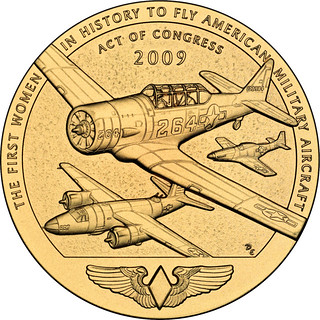
For the medal’s reverse, Don Everhart positioned three aircraft—an AT-6, a B-26 (Martin Marauder), and a P-51—along with the WASP wings emblem and several inscriptions as mandated. The design is exquisitely detailed, with a lightly textured field, and carefully balanced with a nice use of negative space. The positioning of the planes in foreground, middle-background, and background give the design a dramatic sense of movement, depth, and interaction. The text is also well balanced, a technical and artistic challenge with so much wording (THE FIRST WOMEN IN HISTORY TO FLY AMERICAN MILITARY AIRCRAFT and ACT OF CONGRESS 2009).
Everhart made skillful use of the “canvas” available to U.S. medals, which are struck on mint presses different from those used for producing billions of circulating coins. Medal presses apply greater pressure and they strike larger planchets—the bronze versions of this Congressional Gold Medal, available for sale to the public, are up to three inches in diameter, much larger and thicker than any circulating U.S. coin. In Everhart’s design the wings of the AT-6, the dominant figure in the composition, fly off the sides of the medal as if the plane is about to leave its bronze surface and take to the air. The effect is dynamic and breathtaking.
To read the complete article, see:
Favorite Everhart medal and coin designs, part 2: The Women
Airforce Service Pilots Bronze Medal reverse (http://mintnewsblog.com/favorite-everhart-medal-and-coin-designs-part-2-the-women-airforce-service-pilots-bronze-medal-reverse/)
The Presidential Dollar’s Statue of Liberty, 2007–2016
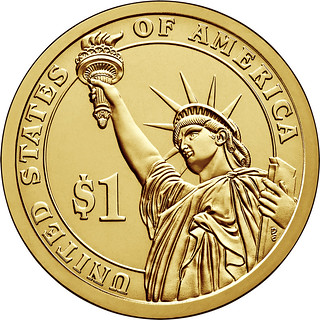
The obverse portraits changed with each president, but the reverse of the coinage series was used on every Presidential dollar minted from 2007 to 2016. Don Everhart created a bold view of the Statue of Liberty, described by the Mint as “a magnificent image.” The statue, Liberty Enlightening the World, is depicted from the perspective of a viewer below, looking up to Miss Liberty holding aloft the torch that represents enlightenment on the way to freedom. The motif is finely detailed and the entire composition, including the UNITED STATES OF AMERICA and the denomination shown as $1, is well balanced.
For its artistry and for its significant place in American numismatics—as the reverse featured on every coin in the Presidential dollar series, a 10-year program of the nation’s largest-denomination circulating coin—this ranks as one of Don Everhart’s greatest designs.
To read the complete article, see:
Favorite Everhart medal and coin designs, part 3: The
Statue of Liberty reverse, Presidential dollar series (http://mintnewsblog.com/favorite-everhart-medal-and-coin-designs-part-3-the-statue-of-liberty-reverse-presidential-dollar-series/)
The Dolley Madison First Spouse Gold Coin, 2007

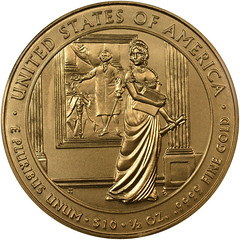
The fourth and final First Spouse coin of 2007 returned to real-life portraiture with a gently smiling visage of Dolley Madison on the obverse, and an artful full-body standing portrait on the reverse. The latter captures the First Lady in the midst of saving the executive mansion’s Cabinet papers and the famous Gilbert Stuart painting of George Washington from seizure by advancing British troops in August 1814. Collectors remarked on the attractiveness of the reverse tableau.
As the First Spouse series and other U.S. Mint programs continued, the Citizens Coinage Advisory Committee increasingly pushed for symbolic rather than pictorial coinage designs. The idea was to move away from “pictures or photographs on coins” and into the realm of artistic allegory. Even though Joel Iskowitz’s reverse design is in the “picture on a coin” category, it succeeds not least of all because of the rich, wonderful texture and sculptural depth imparted in Don Everhart’s engraving. Dolley Madison’s hair, her clothing, the painting of George Washington—Everhart captured every detail. The nuances are particularly visible in the Uncirculated version of the coin.
To read the complete article, see:
Favorite Everhart medal and coin designs, part 4: The Dolley Madison First
Spouse gold coin (http://mintnewsblog.com/favorite-everhart-medal-and-coin-designs-part-4-the-dolley-madison-first-spouse-gold-coin/)
The 2006 Dalai Lama Congressional Gold Medal
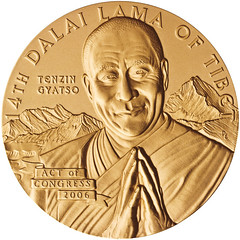
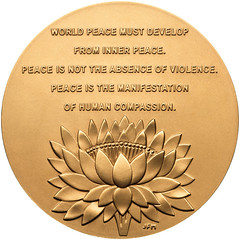
The obverse is a beautiful portrait designed and rendered by Don Everhart. Don was my second in command and could model a portrait faster than anyone I ever knew. He is also one of the premier medallic artists in the industry. This is a wonderfully balanced piece. The simplicity of the reverse perfectly reflects the simple life of the Dalai Lama.
The 2014 National Baseball Hall of Fame Commemorative Coins

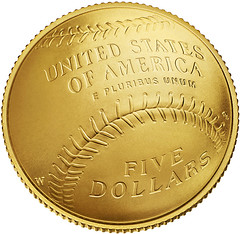
Although the United States has issued many gold commemorative coins from 1903 to date, including dozens in the modern era since 1984, the novelty of one in particular warrants its inclusion in this chapter. In 2014 the U.S. Mint released a suite of three commemorative coins—a half dollar, silver dollar, and $5 gold piece—celebrating the 75th anniversary of the National Baseball Hall of Fame in Cooperstown, New York. These coins are unique in that they were the first-ever curved coins produced by the Mint. Their obverses are concave, to recreate the cupped curvature of a baseball glove, and their reverses are convex, like the surface of a ball.
Other world mints had created curved coins before, but for the United States Mint these coins were an innovation. Don Everhart sculpted the concave baseball-glove side of the coins based on a design idea by Cassie McFarland. He designed and sculpted the convex baseball side. These coins captured the imagination of the American public and made national headlines in a way that few other modern coins have.
The coins and medals we’ve explored this week are just a sampling of Don Everhart’s work for the United States Mint. Over the course of almost 14 years he designed and/or engraved more than 100 works of art for the American people. Everyone at Whitman Publishing wishes Don a long and happy retirement—or semi-retirement, at least, as he continues sculpting and designing in the private sector while spending more free time with his family. And we extend our grateful thanks for a productive career that gave the United States many excellent coins and medals to collect and enjoy.
To read the complete article, see:
Favorite Everhart medal and coin
designs, part 5: The Dalai Lama medal and National Baseball Hall of Fame commemorative coins
(http://mintnewsblog.com/favorite-everhart-medal-and-coin-designs-part-5-the-dalai-lama-medal-and-national-baseball-hall-of-fame-commemorative-coins/)
TOM BABINSZKI INTERVIEWS THE NUMISMATOURIST
Over the last months I had a few conversations with Dr. Howard Berlin, the Numismatourist. I think the story around his book is just as interesting as the book. I am happy to announce, he agreed to an interview on this blog. I thought my readers would be interested in the background story as well. So, for a lack of better interviewer, I had the pleasure to ask him a few questions.
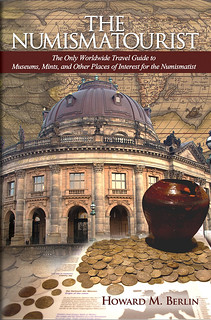 Tom: Why did you think about publishing a book about money museums?
Tom: Why did you think about publishing a book about money museums?
Numismatourist: At the time I was writing a column, “world Destinations,” in Worldwide Coins, then a sister publication of Coin World. I had material for many more museums that I had visited than I could ever put in my columns, so I thought about putting them together into a book – a topic for which there was no book on the market.
Tom: How did you become interested about this topic?
Numismatourist: I have a number of interests and hobbies. In no particular order of preference, three of them are writing, numismatics, and travel. Currently I have been to more than 60 countries. I like to visit museums when I travel, especially archaeology and history museums (i dislike art museums and exhibits).
Tom: Are you a coin collector?
Numismatourist: Currently, no. I had collected coins and banknotes of the British Palestine Mandate and National banknotes with cities having the town of Berlin, or a variation, such as New Berlin. At the time I had over 35 notes from all such banks except two – the late Chet Krause had the only known known note from charter number 400 from New Berlin, Wisconsin. I also had a number 1 serial $5 note from the National Bank of Berlin, New Jersey and a few uncut sheets of $5 notes from the same bank. I had the pleasure of exhibiting my collections locally and nationally. However, because of its value, security of storing it and transporting material for exhibiting became an increasing problem. After almost 30 years of collecting and exhibiting, I decided to sell the collections to various dealers, most of whom had helped me acquire the items, many of which were rarities. Also, my children, all fully grown, had expressed no interest in numismatics.
Tom: Did you see all the museums in person you wrote about? Numismatourist: In my book, there are about 100 museums that have complete descriptions and photos. Of these, I had visited over 60. Information for the remainder were supplied by the museums themselves.
Tom: Your book inspired me to visit some of the museums you listed. Did you receive any similar feedback when your book was the motivation for someone to visit a museum?
Numismatourist: Yes, several people have e-mailed me or stopped me at Ana shows telling me how it helped with their travels here in the U.s. or abroad.
To read the complete article, see:
Interview with the Numismatourist
(http://blindcoincollector.com/2017/08/12/interview-with-the-numismatourist/)
To read the earlir E-Sylum article, see:
NEW BOOK: THE NUMISMATOURIST (http://www.coinbooks.org/esylum_v17n31a03.html)
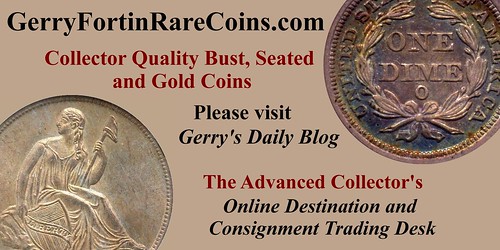
VOCABULARY TERM: LIMITED EDITION
Limited Edition. A controlled quantity of an object whose production and sale to the public will not exceed the number stated when the object is first offered on the market. The size of the edition is sometimes stated on the object – on medallic items if may be a part of the edge lettering – and often has a serial number which should not exceed that edition size. No one, however, has the insight to know for certain exactly how many of any collectible item will sell, least of all the publisher who must set the edition limit who tries to set an educated guess.
Establishing a limited edition quantity is difficult, no amount of market research will reveal what this size should be, and it is often a no-win situation. Under estimating market demand – and setting too low an edition size – will result in lost profits. Overestimating the demand – and setting too high an edition size – results in unsold remainders. If the former happens an unscrupulous publisher may want to supply the demand and create duplicate numbers, or create a slightly different new edition, both of somewhat questionable ethics.
In theory unsold remainders preclude any limited edition item from advancing in value (anyone who wants the item or set can obtain it easily). In reality, however, it sometimes creates greater demand because they are available, advertised and promoted to new buyers.
Collectors prefer small editions, making any piece they own as rare as possible. Publishers like large edition sizes to maximize their profits. While setting edition sizes as an estimate at best, a crystal ball game, and no amount of logic will dictate a limited edition size for any particular item, integrity is more important than size.
With the rise of mass manufactured collectible items (plates, medals, figurines, chess sets, et al since the 1960s), a new concept of limited edition arose: the cut off date. As many people who
wanted the item could order by a certain date – that gave the maker the exact number to manufacture – and the size of the edition. This curtailed any remainders overhanging the market.
CLASS 12.4
MYRON XENOS (1938-PRESENT)
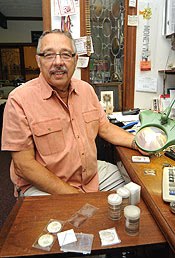 Myron Xenos was born on August 3, 1938 in Cleveland, Ohio. As a young man he collected stamps, coins and their literature. In May 1956 he won third place award for his stamp exhibition at
the Fifth International Philatelic Exhibition (FIPEX), at the New York Coliseum.
Myron Xenos was born on August 3, 1938 in Cleveland, Ohio. As a young man he collected stamps, coins and their literature. In May 1956 he won third place award for his stamp exhibition at
the Fifth International Philatelic Exhibition (FIPEX), at the New York Coliseum.
In September 1961, he joined the ANA as Member No. 42733, listed as a collector of U. S. and Canadian coins. He seems to have had a natural predilection for U. S. Bust-type half dollars.
On December 16, 1961, he married Daryl Eckert, daughter of Samuel M. and Margaret F. Eckert. They had two daughters. He graduated Kent State University in 1962. He opened his own accounting firm in 1962.
 In 1967 he began selling numismatic literature doing business as Security Coin Trust. In 1971, he was partners with brother in-law Gary B. Eckert, and Harry Mueller in Leo Vending. This is
where he acquired many rare coins.
In 1967 he began selling numismatic literature doing business as Security Coin Trust. In 1971, he was partners with brother in-law Gary B. Eckert, and Harry Mueller in Leo Vending. This is
where he acquired many rare coins.
In 1978, he became a partner as a real-estate developer with Xenophon Zapis in the Tiffany Ridge Corporation building condominiums at Rocky River.
Also in 1978, he was a restauranteur as well as an antiques expert and owned a restaurant in Beachcliff Market Square which had music played by a Marantz Piano Corder that played music on magnetic tape.
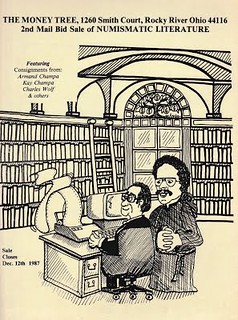 In the September 1980 issue of The Numismatist on page 2375 he advertised as The Money Tree, a coin dealership specializing in foreign crowns and dollars, 1260 Smith Court, Rocky River,
Ohio.
In the September 1980 issue of The Numismatist on page 2375 he advertised as The Money Tree, a coin dealership specializing in foreign crowns and dollars, 1260 Smith Court, Rocky River,
Ohio.
In 1981, he served the T. V. auction show on Channel 25 as the rare coin dealer.
In 1986, he became partners with Ken Lowe in the firm of The Money Tree. Myron was the president and owner, and Ken Lowe was the editor.
The Money Tree began holding mail bid auctions of numismatic literature in July 1987, and published their house organ Out on A Limb. They held thirty-two auctions, which only twenty-eight are known by me. Their last auction was held on December 4, 1999.
To read the complete article, see:
XENOS, MYRON G (https://sites.google.com/a/numismaticmall.com/www/numismaticmall-com/xenos-myron)
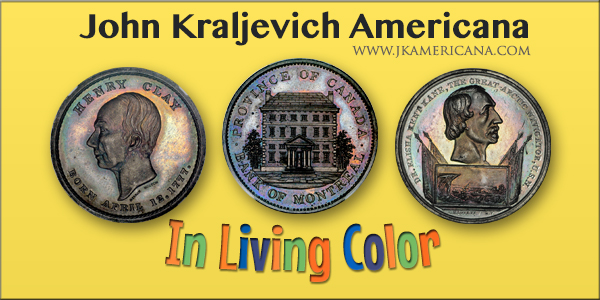
DISPLAYING THE JOSIAH K. LILLY COLLECTION
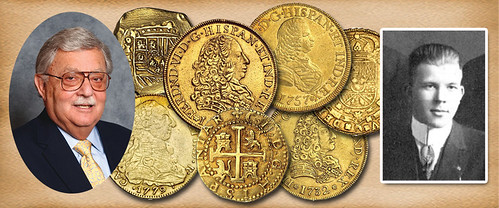
Why was it so important that the Josiah K. Lilly Collection become part of the National Numismatic Collection at the Smithsonian? What made this collection so important and what made the building of the Lilly Collection possible? The quality and quantity of the coins were so exceptional because Mr. Lilly could acquire full or nearly full sets formed by collectors before him. These included $1 to $4 gold from the Anderson Dupont Collection; $5 and $10 gold from the Clifford Weihman Collection; $20 double eagles from the Robert Schermerhorn Collection; Pioneer and Territorial gold coins from the F.C.C. Boyd and the Brand collections. All these became available during the 1950s and early 1960s. This was a somewhat unique period when there was a great change of ownership from some old time collections to a new group of buyers.
In addition, World gold coins and Ancient gold coins also became available during this period partly as a result of World War II. Additionally an advance in prices on the market caused many collectors at this time to choose to sell by private sale or at public auction. Stack's had a number of sales during the period, and many coins that had been difficult to find earlier became available. We were fortunate to be able to acquire many items during this time as we took advantage of the situation.
Josiah K. Lilly was collecting at the right time and place!
Once Congress approved the Bill to acquire the Lilly Collection coins for the Smithsonian in Washington, D.C., the collection was carefully packed, under the personal supervision of Dr. and Mrs. Clain-Stefanelli, and shipped by armored truck to Washington. I was honored to be invited to the Smithsonian for the arrival of this great collection, one that I had been involved with for some 16 years. I opened many cases, helped place the coins in special drawers within the vaults of the National Numismatic Collection, and worked with the Clain-Stefanellis and other staff to store the coins until they were ready for display.
Work began on creating an appropriate space to exhibit this massive collection of gold coins to the public. The Smithsonian provided an enlarged gallery for the display of many of its numismatic treasures. It measured more than 3,000 square feet and would have wall cases, and flat display cases. For the wall cases there would be a mounting device for each coin with the description below. The areas for each series were carefully calculated.
Lighting had to be installed to illuminate the collections. I was there many days helping the staff arrange the display, and prepare literature to be distributed to those who came to view this rare collection of gold coins. I was present during the grand opening, and it received rave notices from visitors and great publicity from the world press. It was an historic event!
To read the complete article, see:
Building a World Class Numismatic Gold Coin Collection The Josiah K. Lilly Collection Part 33
(http://www.stacksbowers.com/News/Pages/Blogs.aspx?ArticleID=2643)
To read the earlier E-Sylum articles, see:
DONATING THE JOSIAH K. LILLY COLLECTION (http://www.coinbooks.org/v20/esylum_v20n31a25.html)
DAVE PERKINS' 2017 JRCS ANA SHOW REPORT
I had a great time at the 2017 ANA World’s Fair of Money in Denver, and with my fellow John Reich Collectors Society (JRCS), ANA members, collectors, and dealers.
One highlight of the ANA for me was John McCloskey showing up at the JRCS meeting on Wednesday morning. John and Russ Logan were the authors of Federal Half Dimes 1792 – 1837. John was a also a co-author of Early United States Dimes 1796 – 1837. At least one lucky JRCS member happened to have his half dime book at the meeting and was able to get John to sign the book and pose for a photo. John was a long time officer in JRCS and also the Liberty Seated Collectors Club (LSCC).
John’s appearance may have been little bit of an omen as we had a successful Fixed Price and Sealed Bid sale of rare Capped Bust Half Dimes, with rare die marriages and remarriages, Condition Census Specimens, a fair number Plate Coins from the Logan-McCloskey book, and late die states (cuds!). This sale was cataloged by Richard Meaney, and he was busy until Friday at 6:00PM at my table showing lots and talking with half dime enthusiasts. At more than one time there were four or five collectors talking and viewing half dime sale lots at the same time!
Dr. Glenn Peterson hosted a meeting of the JRCS Bust Quarter Club. David Lange from NGC was the guest speaker. The subject of his talk was the newly discovered 1822 B-3 Capped Bust Quarter, a new die marriage of 1822 Obverse I and Reverse T with the “Broken Top Arrowhead.” I made time to get away from my table to listen to David Lange’s talk. Unfortunately the Discovery Specimen of this new quarter die marriage was not shown at this meeting, but you can view a photo of it on the copy of the latest issue of the John Reich Journal.
Another highlight for me was attending Chuck Link’s presentation and talk Thursday afternoon at the Bust Half Nut Club General Meeting. There had to be over 50 people in the room. Chuck Link’s presentation was titled, “Collecting Liberty Capped Half Dollars and Stories Along the Way, a Journey with Friends.” Chuck shared a number of stories about the acquisition of rare and choice CB Half Dollars, and those who helped him in his Journey. I have a pretty nice 1807 “Beard Goddess” half dollar in my collection but Chuck topped this by having three high Condition Census examples in three different die states (photos below)! Here’s a link to Chuck’s Capped Bust Half Dollar PCGS Registry Set: https://www.pcgs.com/SetRegistry/half-dollars/early-half-dollars-specialty-sets/capped-bust-half-dollars-prime-die-variety-set-by-overton-circulation-strikes-1807-1836/alltimeset/93314.
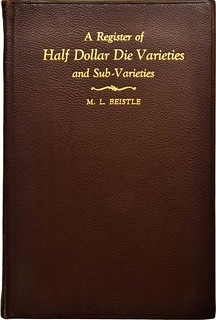 Chuck’s talk was captured on video by the ANA. [I’m not sure how one might go about trying to find and view / listen to this video.]
Chuck’s talk was captured on video by the ANA. [I’m not sure how one might go about trying to find and view / listen to this video.]
Chuck Link also shared a slide on his recently acquired copy of the Beistle book on half dollars, a copy formerly owned by one of my favorite research subjects, Col. E.H.R. Green. The book was inscribed in 1929 to Col. Green from Beistle inside the front cover.
I unfortunately had to miss David Finkelstein’s presentation, “The 1,758 1794 Silver Dollars: Recently Found Mint Documents Dated 1794 and 1795.” Fortunately I talked with David earlier in the week and he filled me in on some of his new findings.
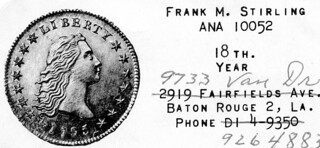 As always, I enjoyed talking with the many collectors and dealers that attended the show. Collector and Numismatist Jimmy Hayes knows of my interest and research into current and former
collectors and collections of early dollars 1794 to 1804, and in particular Frank M. Stirling of Baton Rouge, LA. At the show Mr. Hayes gave me as a gift an old business card of Stirling’s that I had
never seen before. My friend Jim Matthews pointed out the 1795 Flowing Hair Dollar photo on the card was the obverse of the R-8 1795 B-16 Dollar. I have seen this coin and it remains with the
Stirling family to this day.
As always, I enjoyed talking with the many collectors and dealers that attended the show. Collector and Numismatist Jimmy Hayes knows of my interest and research into current and former
collectors and collections of early dollars 1794 to 1804, and in particular Frank M. Stirling of Baton Rouge, LA. At the show Mr. Hayes gave me as a gift an old business card of Stirling’s that I had
never seen before. My friend Jim Matthews pointed out the 1795 Flowing Hair Dollar photo on the card was the obverse of the R-8 1795 B-16 Dollar. I have seen this coin and it remains with the
Stirling family to this day.
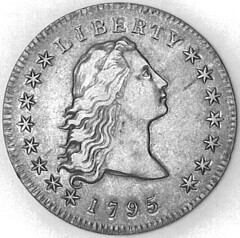 This too may have been an omen as toward the end of the show I was able to place the unique 1795 B-21, BB-28 and the R-7, 1795 B-8, BB-15 Dollars from the Warren Miller Collection with a
new early dollar collector. The 1795 B-8, BB-15 Dollar is the finest known specimen by far and has passed from early dollar collector to early dollar collector over the years, starting with F.C.C.
Boyd (1945 World’s Greatest Collection), Adolph Freidman, Milferd H. Bolender (and the Bolender Plate Coin), K. P. Austin, Alfred and Jacque Ostheimer, H. Roland Willasch, Jim Matthews, and Warren
Miller. As Andy Lustig and I purchased the Miller early dollar collection I guess you might say that technically Andy and I have owned the coin (if only for a year or so)! For more on this coin and
the rare 1795 Dollars please see my article, “The Story of Bolender’s 1795 Flowing Hair and Draped Bust Dollars” in the latest issue of the John Reich Journal (Volume 27 / Issue 2) on pages
29-38.
This too may have been an omen as toward the end of the show I was able to place the unique 1795 B-21, BB-28 and the R-7, 1795 B-8, BB-15 Dollars from the Warren Miller Collection with a
new early dollar collector. The 1795 B-8, BB-15 Dollar is the finest known specimen by far and has passed from early dollar collector to early dollar collector over the years, starting with F.C.C.
Boyd (1945 World’s Greatest Collection), Adolph Freidman, Milferd H. Bolender (and the Bolender Plate Coin), K. P. Austin, Alfred and Jacque Ostheimer, H. Roland Willasch, Jim Matthews, and Warren
Miller. As Andy Lustig and I purchased the Miller early dollar collection I guess you might say that technically Andy and I have owned the coin (if only for a year or so)! For more on this coin and
the rare 1795 Dollars please see my article, “The Story of Bolender’s 1795 Flowing Hair and Draped Bust Dollars” in the latest issue of the John Reich Journal (Volume 27 / Issue 2) on pages
29-38.
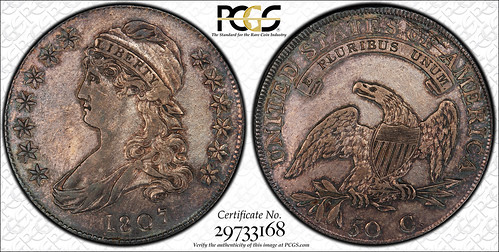
Early die state of 1807 "Bearded Goddess" half dollar
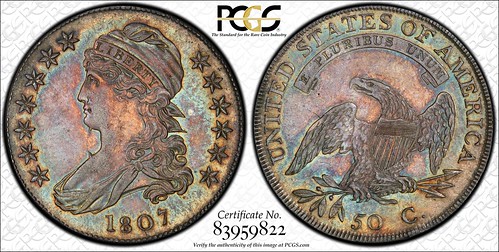
Intermediate die state of 1807 Bearded Goddess
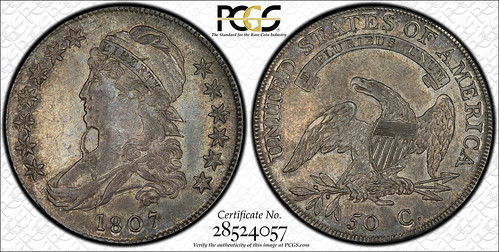
Late die state of 1807 Bearded Goddess.
To read the complete newsletter issue, see:
http://mailchi.mp/bc0d0e4c204d/jr-newsletter-6-august-2017-355?e=9b1d009ea9
For more information on the John Reich Collectors Society, see:
https://www.jrcs.org/
JOINED HALVES COUNTERFEIT 1889-CC MORGAN DOLLAR


The 1889-CC Morgan dollar pictured above appears to be an attractive coin in About Uncirculated condition worth well over $10,000. In reality, however, it is an alteration made from two coins carefully cut and then joined together to create a different date and mintmark combination. In this case, the obverse and edge of an 1889 Philadelphia dollar were combined with the reverse of one of the more common CC-mint Morgan Dollars, most likely an 1883 or 1884.
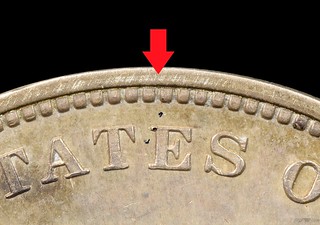 A careful examination of this coin reveals a seam in the middle of the rim on the reverse. This seam was created when the forger removed the entire reverse of the 1889 Philadelphia dollar
from within that line and replaced it with a reverse removed from a more common Carson City issue. The diagonal scratches on the rim are the counterfeiter’s attempt to remove evidence of the
joint.
A careful examination of this coin reveals a seam in the middle of the rim on the reverse. This seam was created when the forger removed the entire reverse of the 1889 Philadelphia dollar
from within that line and replaced it with a reverse removed from a more common Carson City issue. The diagonal scratches on the rim are the counterfeiter’s attempt to remove evidence of the
joint.
Overall, the counterfeiter did a decent job—this is one of the more deceptive counterfeits seen recently at NGC. Even the weight of this piece, 26.48 grams, is pretty close to the official weight of 26.73 grams. However, that difference is actually two and a half times the Mint’s weight tolerance of +/- 0.097 grams.
A good way to check for authenticity issues is to try to match the coin to known dies. Morgan Dollars, for example, have been extensively cataloged by die variety (called “VAMs” after the comprehensive study by Leroy Van Allen and A. George Mallis). If your coin does not match any known die pairs for the date and mintmark combination, you either have an important discovery or a counterfeit. Either way, this should cause you to more intensely scrutinize the coin.
To read the complete article, see:
Counterfeit Detection: 1889-CC Morgan Dollar with Joined Halves
(https://www.ngccoin.com/news/article/6062/counterfeit-detection/)

BRIDGES TO NEWER GENERATIONS OF COLLECTORS
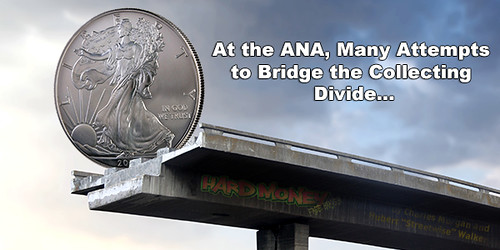
John spoke of the old days. He is just as passionate about silver dollars today as he always was. But even he took a look at the bourse floor and knew that today's hobby was much different than it was years ago.
One bright point of our conversation came when he wanted to introduce Charles to an ANA page. "This kid is brilliant," he said, "and you should get to know him. He came to my table and talked about 1893-S Morgan dollars..."
Imagine the sight: Charles with a giant camera rig, scurrying across the bourse to catch up to a 13-year-old page that wanted nothing to do with talking to either of them.
The moment was innocent but awkward, and it really made us think about whether all of this effort and discussion about how to attract young collectors to the hobby is misguided. Not that young people shouldn't be part of our community, but that we put undue (and unfair) weight and attention on them.
Instead of letting them be and grow into themselves, we give them the moniker "young numismatist" and place all of *our* hopes and aspirations for the future of the hobby on their shoulders.
Imagine how off-putting that would be if you were a teenager. By avoiding us, that 13-year-old kid made his point as eloquently as we deserved.
To read the complete article, see:
At the ANA, Many Attempts to Bridge the Coin Collecting Divide
(http://www.coinweek.com/opinion/at-the-ana-many-attempts-to-bridge-the-coin-collecting-divide/)
At this meeting, the discussion centered around two young numismatists in attendance.
The senior members of the club wanted to learn from the two YNs how their club could better reach out to young people and their friends.
At any rate, the one thing absent from this discussion and the earlier symposium at the NLG was how we can better communicate to collectors already in the hobby that don't feel like they are part of our community - that is, the community of collectors that would join organizations like the EAC or take up the challenge of writing the next great numismatic article or book, replenishing our ranks with new blood and new ideas.
It is our belief that some collectors drop in and out of the hobby over the course of their lives. Others may collect for years--their whole lives, in fact--and never advance their knowledge to the point where they would feel comfortable calling themselves "numismatists". Still others see the hobby as having great potential. If we are lucky, these people are provided the opportunity to grow and mature as true numismatists and future leaders. It is on us to always present a welcoming environment, a call to participate, and a community worthy of their talent and time. If anything, what we have failed to do in recent years is to offer a compelling alternative to self-directed collecting, detached from the social ties that have long bound the hobby together.
Coins are interesting things collected by interesting people. Our website's focus is discussing coins and the lifestyle of collecting. It is our belief that the industry is best served by taking this to heart and leaving the gimmicks at the door. Prices do not dictate the viability of the coin market. The fascination of coins and related objects does.
Even our youngest "numismatists" know that.
There's much more to the article - be sure to read it online. -Editor
NUMISMATIC NUGGETS: AUGUST 13, 2017
1868 Marquis Henri de Rochefort Medal

Marquis Henri de Rochefort 1868
Très belle fonte ancienne
ø 160 mm
To read the complete lot description, see:
Marquis Henri de Rochefort 1868 (http://www.gimbert-numismatique.com/achat/produit_details.php?id=635)
2004 Banksy Di-faced Tenner
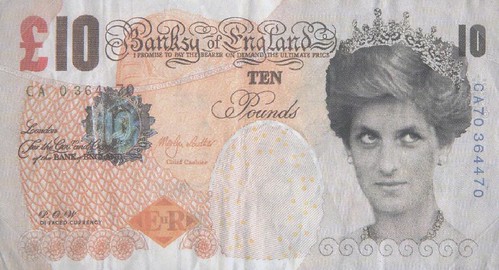
Artist: Banksy
Title: Di-faced Tenner
Printing Date: 2004
Medium: Offset Litho S
ize: 7.6 x 14.3 cm
Publisher: Pictures On Walls
Series: Unknown
Offset lithograph printed in colours, 2004, printed by Pictures on Walls, London, the full sheet printed to the edges.
To read the complete lot description, see:
Banksy Di-faced Tenner Lithograph
(https://new.liveauctioneers.com/item/54903858_banksy-di-faced-tenner-lithograph)
ON BIBLIOKLEPTOMANIA
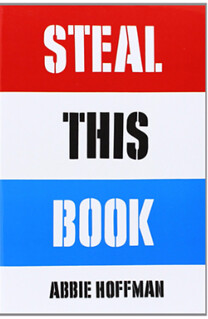 Bibliokleptomania is the uncontrollable impulse to steal books — and according to a recent article published by The Guardian, book thieves come from all walks of life.
Bibliokleptomania is the uncontrollable impulse to steal books — and according to a recent article published by The Guardian, book thieves come from all walks of life.
Some recent cases of bibliokleptomania that made headlines include that of Farhad Hakimzadeh, an Iranian businessman who tore pages out of rare books at the British and Bodleian libraries and put them in his own books to increase their value. One of the pages contained a map worth over $42,000.
Another thief, Stanislas Gosse, used secret ancient passageways to break in and flee the Mont Sainte-Odile, a French monastery, with stacks of centuries-old volumes — some old enough to have wooden covers. “Inside the library, Gosse spent hours by candlelight picking out volumes, some of which he stored in the attic. . . . Gosse told the court: ‘I’m afraid my burning passion overrode my conscience. It may appear selfish, but I felt the books had been abandoned. They were covered with dust and pigeon droppings and I felt no one consulted them any more. There was also the thrill of adventure – I was very scared of being found out.’”
Mounties in Canada seized over 1,300 items from the home of John Mark Tillman. He stole “hundreds of antiques, rare books, pieces of art carefully displayed, part of a trove that included a suit of armour, a large oil painting of a seascape, old marriage certificates and papers associated with the historic schooner, the Bluenose.” Tillman displayed the artifacts stolen from museums and libraries in his suburban home like the curator of his own museum.
To read the complete article, see:
When People Steal Books (http://flavorwire.com/608745/when-people-steal-books)

KELLEN HOARD'S 2017 DENVER ANA DIARY
The ANA World’s Fair of Money is one of the most well-known events in numismatics. Each August, hobbyists from around the world meet up to talk, learn, buy, and sell everything numismatic. I had the good fortune of attending this year’s show in Denver, and as always it was a highlight of my numismatic year.
Wednesday
I started my journey at the Sea-Teac airport on Wednesday, August 2. An approximately three-hour flight found me in Denver. Instead of a taxi, it was deemed more economical to take a train. Upon
arrival at Union Station, free mall buses were utilized for transportation to my destination: the Holiday Inn Express. It was here that my mother and I (she was accompanying me on this vacation) were
to stay for the rest of the convention. By the time we arrived in Denver it was too late to attend the convention. Fortunately, it was still possible to attend the Heritage Auctions Platinum Night.
Some major rarities were up for auction, such as a 1792 half disme and a 1943 copper cent. Even though I was unable to stay the entire time, I got the most important thing: the auction catalog!
Thursday
On Thursday, I hit the bourse at 9:30 sharp. I spent about half an hour speaking to various people including John Kraljevich and David Lange. In my wanderings, I was also able to acquire a few sample
slabs from both PCGS and NGC. At 10:00 I quickly made my way to a Money Talk by David Finkelstein on 1794 dollars. The talk was fascinating, informative, and consisted of good reasoning. I shall be
interested to see where his research continues in the future. Another note: the distance between the bourse and Money Talks was long. I am sure many numismatists got some serious leg exercise! After
the talk, I made my way back to the bourse. My mother met up with me and we explored the exhibits and the U.S. Mint section. While she is not a numismatist, she likes the history.
My mother left and I decided to complete the ANA’s Treasure Trivia. If any of you know any YN or child attending an ANA convention, I highly recommend suggesting this excellent program. Through the program, I have learned many pieces of useful, interesting, and engaging information. By the time I had finished, the Numismatic Bibliomania Society Symposium was about to begin. Another long walk took me to Room 407. The symposium consisted of a talk by Neil Musante about his two-volume book set Medallic Washington. He mainly described the story and process behind creating the book. A favorite among the audience was his examination of George Washington’s descendants. Ultimately, all I can say is that I am now starting to save up for his books and you should be as well.
After the meeting, I walked with Joel Orosz back to the floor, and we ran into Scott Rubin. The three of us talked about a variety of topics including Armand Champa and the Money Tree until it was time for the book signing of 1792: Birth of a Nation’s Coinage. Unbeknownst to us, it was set to win the NLG Book of the Year award that night. After I got my copy of the book signed, I stopped by Charles Davis’ table. My pick-ups consisted of a copy of Penny Whimsy and a third edition of Overton’s Early Half Dollar Die Varieties. Upon acquiring these I exited the convention and walked back to my hotel room. Quickly, I unloaded my new purchases and ate dinner at a Thai food stand – that had run out of noodles! Soon, I was back to the convention center for the sample slab collector second annual meeting. Here, six of us discussed everything from new purchases to ideas for maintaining relevant information on sample prices and varieties.
Friday
My first event of the day was the EAC General Meeting. While coppers are not one of my main specialties, there is a lot to learn from the people involved. Just a few of the big names present were
Denis Loring, Charles Morgan, and Rob Rodriguez. After general EAC business, the conversation evolved into a discussion on the future of the hobby, specifically the impact of social media and the
internet. Various obstacles to overcome were presented. Foremost among them seemed to be teaching the older generation more about utilizing technology. I hope to write an article further detailing
the discussion soon.
After the meeting was over I talked some more with various members of the club individually. Eventually, I was able to spend some serious time on the bourse. At 11:30, it was time for the Numismatic Bibliomania Society general meeting. Many notable numismatists were there, and I finally had an opportunity to meet the illustrious John Adams. Incoming President Tom Harrison started off the meeting. Len Augsburger followed up with the financial details. Next, our editor gave an informative presentation on the making of The E-Sylum. Finally, the NBS Benefit Auction took place. With David Fanning as the auctioneer, all the lots sold and raised some more money for 2018.
After exiting the get-together, I ended up speaking to Douglas Mudd, the ANA curator, for a while. Directly afterwards, I met Roger Burdette at the Whitman booth. I had done some transcription work for him, and it was an honor to speak with him in person. At 2:00, I headed to Room 501 for a Money Talk by Joel Orosz and Len Augsburger (with additional commentary from Pete Smith) on the coinage of 1792. I thought their presentation was well-done and engaging, to say the least. Afterwards, I finished working my way through the dealers on the bourse. It was then time for my return to the hotel.
At 6:30 PM, my mother and I arrived at Bistro Vendome, a rather fancy French restaurant. Inside we met up with Len Augsburger, and soon were joined by Len’s wife Debra Kurtz, Joel Orosz, and Wayne Homren. Dinner was delicious, and the topics of conversation were entertaining. This was by far the most enjoyable part of my convention.
Saturday
As I had no plans, my mother and I walked around the bourse floor finishing things up. I picked up the final PCGS signed promotional slab, and we both went to view which exhibits had won awards. My
mother discovered that the exhibit she had voted for People’s Choice was the second runner-up and was rather proud of herself. After mailing off some catalogs I had bought, we left the convention
center and took a bus to Union station after a fast lunch at a local café. The train ride was uneventful, as was the airplane flight.
If the World’s Fair of Money is ever located near you, I highly recommend attending. If you are an ANA member, admission is free. If not, access can be gained for a nominal fee or for free on Saturdays. The numismatic world awaits inside!
DETECTORIST UNCOVERS ROMAN HACKSILVER HOARD
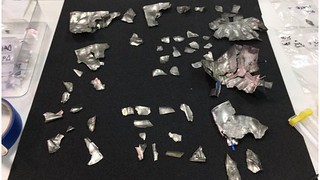 A hoard of Roman silver discovered by a teenage metal detectorist in his "first proper find" is to go on display in Scotland.
A hoard of Roman silver discovered by a teenage metal detectorist in his "first proper find" is to go on display in Scotland.
David Hall, from Livingston who is now 16, found the hacksilver in Fife when he was aged 14, in 2014.
The silver was believed to have been used by Roman soldiers to bribe Picts while passing through Scotland.
David said he did not initially realise the importance of the find and is excited to see how it now looks.
The Dairsie hoard dates to the late 3rd century AD and is the earliest hacksilver from anywhere beyond the frontiers of the Roman Empire.
The find has been hailed as "internationally significant" and will go on show for the first time in a new exhibition at the National Museum of Scotland in October.
Hacksilver consists of silver objects hacked into pieces to make raw bullion.
Archaeologists think the silver came to Fife as a gift or payment from the Roman world.
The Romans could not just rely on the strength of their army - they also used diplomatic efforts to secure the empire's borders by buying off surrounding tribes.
Curators have undertaken a daunting jigsaw puzzle, reconstructing four Roman vessels from more than 300 fragments, as well as examining how they had been cut into packages of bullion.
To read the complete article, see:
'Significant' Roman silver hoard found in Fife by teenager
(http://www.bbc.com/news/uk-scotland-edinburgh-east-fife-40778533?SThisFB)
Hacksilver or hacksilber, are fragments of cut and bent silver items treated as bullion, either for ease of carrying before melting down for re-use, or simply used as currency by weight. It was common among the Norsemen or Vikings, as a result of both their raiding and trade. Hacksilver may also have been used by Romans in their dealings with Pictish tribes.
To read the complete article, see:
Hacksilver (https://en.wikipedia.org/wiki/Hacksilver)

ENGLISH STACKING WEIGHTS WITH U.S. COPPERS
This is an interesting curiosity! The brass part is an original English flat brass weight, most likely a 2 oz, and part of a set of stacking weights typically used with a balance scale. It has a number of marks and numbers that date it to the 1930s. The 'crowned GR' mark (the "GR" standing for the Latin "George Rex" or King George) is a government Weights & Measures verification mark that was used between 1910-1952 during the reigns of King George V and King George VI. The two digit numbers are the various years that the weight was inspected and verified. "33" (1933) appears to be the earliest and "42" (1942) the latest, which gives you an irrefutable span of years when it was in use.
Under the "GR" there's a small "54" which is the code number for the County of Cheshire, meaning that this weight was issued, verified and inspected in that county.
The British Weights & Measures marking system was never standardized and it was up to individual local jurisdictions to make their own arrangements and marks, so each county, barony, hundred, borough, city, town, manor, parish etc, had its own system. The only constant was the crown verification mark. So without that, it's impossible to be more accurate than to say these auxiliary marks are most likely year ciphers. The "A26" could be "Anglesea 1926" (if it's stacked A/26)

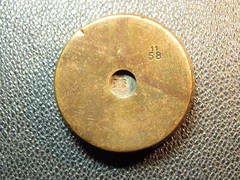
1793 Chain cent 67.9 gms Rev (11/58)
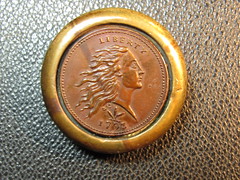
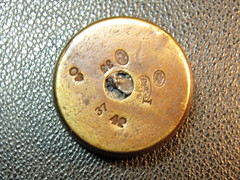
1793 Wreath cent 66.6 gms Rev (GR/54) (I 33 37 40 42)
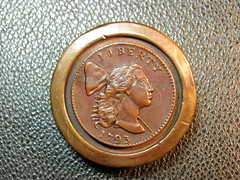

1793 Lib. Cap cent 65.7 gms Rev (A/26)
FOR THE LOVE OF MONEY EXHIBIT COMES TO MOAF
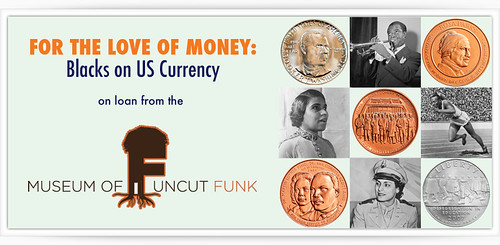
Loreen Williamson and Pamela Thomas know that there are funkier figures in history than Booker T. Washington. Bear with them, though, and they will connect the dots that landed him in the Museum of UnCut Funk.
The visage of Mr. Washington, the 19th-century author and educator, is printed on a 1947 half-dollar coin featured in “For the Love of Money,” an exhibition of blacks on United States currency at the Museum of American Finance in Manhattan, on view through January. The show, with more than 35 coins, tokens, medallions and medals that celebrate black history leaders, events and institutions, is on loan from the Museum of UnCut Funk, the online destination for all things funky, which Ms. Williamson and Ms. Thomas began to curate about a decade ago.
“I bet you didn’t know there was all this money with actual black people on it,” Ms. Thomas said. “And I doubt anybody knows the process that was undertaken to get these people put on currency.” That process includes presidential authorization only after two-thirds of both the House and the Senate have first voted to approve the idea, she explained. “If you look at it from the perspective of, ‘Well, damn, I had no idea about this,’” she said, “that makes it pretty funky.”
Ms. Williamson continued, “This may be our most traditional show in that it’s the kind of thing you’d expect to see in a black history exhibition.” She and Ms. Thomas founded the funk museum, which usually focuses more on pop culture, in 2007. Besides Mr. Washington, other figures whose images are cast in bronze, gold and silver within the single-room show on Wall Street in the financial district include Joe Louis, Bessie Coleman and the Tuskegee Airmen.
A few of the objects, like a 2016 Harpers Ferry National Historical Park quarter, representing Washington, D.C., and another from Washington, featuring the Frederick Douglass National Historic Site, issued in 2017, are currently in circulation. But most, like two for President Barack Obama from his first and second terms in office, and Rosa Parks’s 1999 bronze medal, were pressed strictly to honor the subject, not to be used as money. Still, they represent what Ms. Williamson called a funky twist in how people think about the United States Mint.
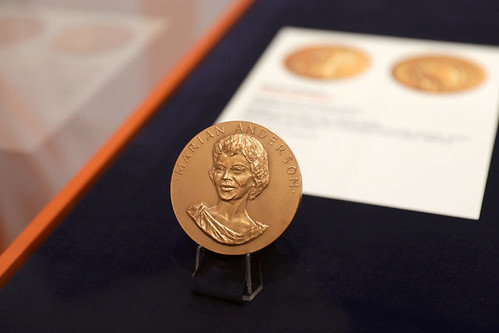
1978 bronze medal of the singer Marian Anderson
Ms. Thomas and Ms. Williamson started to promote “For the Love of Money,” one of five traveling Museum of UnCut Funk shows, in response to the news that Harriet Tubman would replace Andrew Jackson on the $20 bill in 2020. The exhibition’s title is a nod to the O’Jays tune.
“We sort of realized that things have come full circle, with happy slaves being depicted picking cotton on Confederate currency just before the Civil War, to Obama’s bronze medals for being the first African-American president, to Harriet Tubman being on the new 20 and Sojourner Truth having a turn on the 10 and Marian Anderson being on the 5 in 2020 — which I hope still happens,” Ms. Thomas said.
To read the complete article, see:
The Money Museum Gets Funky (https://www.nytimes.com/2017/08/09/nyregion/the-museum-of-uncut-funk.html)
For more information on the Museum of American Finance, see:
https://www.moaf.org/
To visit the Museum of Uncut Funk, see:
http://museumofuncutfunk.com/
To read the earlier E-Sylum article, see:
RECENT COINWEEK VIDEOS AND PODCASTS : Podcast #37: UnCut Funk: African-American Representation and Money
(http://www.coinbooks.org/esylum_v19n30a17.html)
EXHIBIT: FOR THE LOVE OF MONEY (http://www.coinbooks.org/esylum_v19n37a19.html)
LORD ASHCROFT ON CAPTAIN ACKROYD'S MEDALS
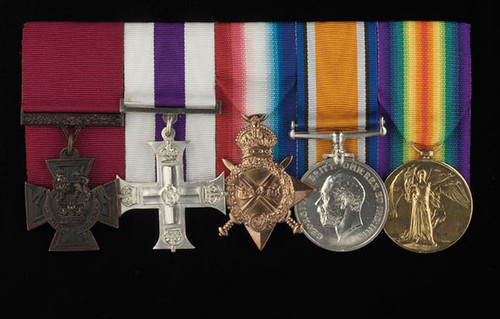
To his commanding officer, Lieutenant-Colonel BE Clay, he was “the most gallant man I have ever met”. To the young soldiers from his battalion, he was an inspirational figure who repeatedly risked his life to tend to their wounds just yards from the front line.
Yet aged 40, bespectacled and with thinning grey hair, temporary Captain Harold Ackroyd was an unlikely hero as he earnestly undertook his medical duties a century ago on the muddy Flanders fields close to the Belgian town of Ypres.
he served in France and Belgium for two long years at the height of the 1914-18 war, the repeated risks that he took made it clear that his commitment to his king, country and comrades was constantly endangering his life.
In fact Captain Ackroyd was killed in action 100 years ago today, 10 days after showing such outstanding bravery in the Battle of Passchendaele that he was awarded a posthumous Victoria Cross (VC), Britain and the Commonwealth’s most prestigious gallantry medal.
I am the privileged custodian of Captain Ackroyd’s gallantry and service medals, having purchased them privately 14 years ago. This is my personal tribute to a man who fully deserves to be recognised as one of the “bravest of the brave”.
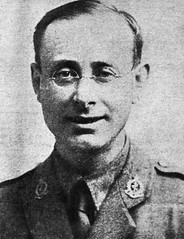 It was on the opening two days of Passchendaele that the Royal Berkshires saw terrible losses as they advanced along and close to the Menin Road as part of the offensive by 53rd Brigade,
30th Division.
It was on the opening two days of Passchendaele that the Royal Berkshires saw terrible losses as they advanced along and close to the Menin Road as part of the offensive by 53rd Brigade,
30th Division.
The attack on Glencorse Wood on July 31 and August 1, though courageous, was confused and poorly organised, as the 6th Berkshires moved closer towards a well-prepared enemy and into an area that was already thought to have been captured.
Captain Ackroyd roamed up and down the line to treat casualties and was eventually awarded the VC for his gallantry over the two days. The citation for his decoration, announced on September 6, 1917, stated:
“During recent operations Captain Ackroyd displayed the greatest gallantry and devotion to duty. Utterly regardless of danger he worked continuously for many hours up and down and in front of the line tending the wounded and saving the lives of officers and men. “In so doing he had to move across the open under heavy machine-gun, rifle and shell fire. He carried a wounded officer to a place of safety under very heavy fire.
On another occasion he went some way in front of our advanced line and brought in a wounded man under continuous sniping and machine-gun fire.
“His heroism was the means of saving many lives and provided a magnificent example of courage, cheerfulness and determination to the fighting men in whose midst he was carrying out his splendid work.”
However by the time that his VC was announced Captain Ackroyd was dead. He had been killed by an enemy sniper at Jargon Trench while close to the front line, having set out to find and treat the wounded on August 11, 1917. He was one of seven men shot dead in a shell-hole by snipers and he was buried at Birr Cross Roads Cemetery, Zillebeke, Belgium.
To read the complete article, see:
A doctor's heroic devotion to duty in fields of Flanders is remembered by Lord
Ashcroft (http://www.express.co.uk/news/history/839757/Remembering-Captain-Harold-Ackroyd-heroic-doctor-war-hero)

ROYAL MINT MUSEUM OF HYDERABAD PROPOSED
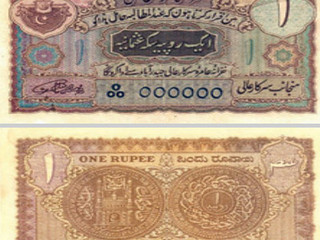 The coinage and currency heritage of Hyderabad now lies hidden within the four walls of the Government of India Mint at Cherlapalli in the city. The common man does not have access to the
rare exhibits kept at the Mint. While most of the equipment originally used in the Royal Mint of the Nizam was consigned to a scrapyard, a few moulds, dies, casts and rare coins and currency of the
Nizam are preserved in the so-called museum at the Mint.
The coinage and currency heritage of Hyderabad now lies hidden within the four walls of the Government of India Mint at Cherlapalli in the city. The common man does not have access to the
rare exhibits kept at the Mint. While most of the equipment originally used in the Royal Mint of the Nizam was consigned to a scrapyard, a few moulds, dies, casts and rare coins and currency of the
Nizam are preserved in the so-called museum at the Mint.
Heritage activists demand that the old mint building in Saifabad should be converted into a numismatics and royal mint museum of Hyderabad with access to the common man. While the mints elsewhere simply stuck coins, the Hyderabad mint of the Nizam's time produced even traffic signals, medals, badges and other memorabilia. Most of them have been consigned to scrap while a few now form part of a private collection of expert numismatics. Incidentally , this is the centenary year of the introduction of paper currency in Hyderabad.
The Hyderabad Currency Act (19171918 CE) got the approval of the Nizam VII, Mir Osman Ali Khan on June 4, 1918. And this was the first time that paper currency was introduced in the princely state of Hyderabad. Till then, only coins with the highest denomination of Re 1 were in circulation. All of them were stuck in silver and they were worth their weight in metal.
Initially, coins were minted and as the princely state faced severe shortage of metal during the World War I, Hyderabad shifted to paper currency . The Nizam got the notes printed in England. Later, the notes were printed at the royal mint as well as Central Press (Government Printing Press, Malakpet) during the World War II. The Nizam ensured that the money printed in England did not fall into wrong hands before the bundles of currency arrived in Hyderabad. The notes would carry all the details except the mandatory signature of the finance member, without which the notes are invalid.The signature was printed in Hyderabad before formal release into the market.
The Nizam first issued 10 and 100 notes in 1918. As the high value notes did not get people's support, the Nizam later introduced 1 and 5 banknotes in 1919. The 1,000 banknote was issued in 1926. The Re 1 note was turned down by people as it was black. Many considered black as inauspicious and refused to accept it.The Nizam was forced to withdraw the black note within a year of its introduction. It was thus the first ever demonetisation of a banknote in Indian history .
To read the complete article, see:
Reclaiming our heritage -
Can't coin history: Nizam's rare currency trapped in mint closet
(http://timesofindia.indiatimes.com/city/hyderabad/reclaiming-our-heritage-cant-coin-history-nizams-rare-currency-trapped-in-mint-closet/articleshow/59909289.cms)
SCOTLAND'S NEW MARY SOMERVILLE POLYMER £10 NOTE
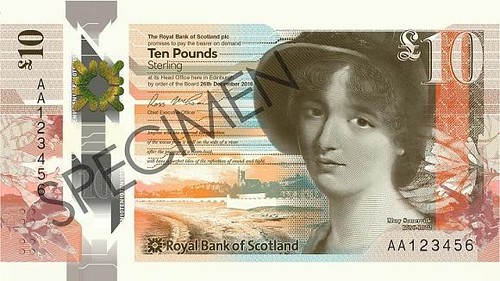
The Royal Bank of Scotland’s brand new polymer £10 note featuring pioneering Scottish scientist Mary Somerville is to be issued on 4 October.
The note will have the secure features put in place by the £5 notes issued by the Bank of England and the RBS in 2016.
RBS says the new note will include braille for the blind and visually impaired.
The £10 plastic note will feature Scottish astronomer Mary Somerville, a pioneering mathematical genius appointed as the first female member of the Royal Astronomical Society, in the nineteenth century.
Born in 1780, she is credited with the discovery of Neptune due to her suggestions of a planet near Uranus.
A Facebook campaign advocated for the scientist to appear on the note after RBS put the matter as to who should be on the new polymer note to an online public vote.
The bank’s chief executive Ross McEwan said that after 30 years, the time had come for RBS to produce a new £10 note.
“We wanted the public to help influence the design,” he said. “They helped influence our theme of ‘fabric of nature’ and helped us consider the impact Mary Somerville has had on our understanding of the world in which we live.”
He added: “It is fitting that our most advanced note yet will carry her portrait.”
To read the complete article, see:
New RBS £10 note featuring Scottish astronomer Mary
Somerville to be released in October (http://www.independent.co.uk/news/business/news/rbs-plastic-10-pound-note-new-mary-somerville-scottish-astronomer-polymer-a7887981.html)
BRITAIN TO CONTINUE POLYMER WITH TALLOW
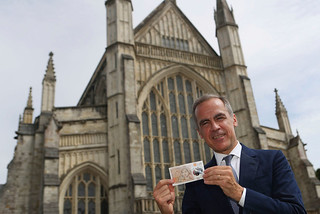 Britain’s new bank notes are harder to forge than their predecessors. They are also more durable, able to survive a washing machine cycle. They can even be dipped in curry with no adverse
effects.
Britain’s new bank notes are harder to forge than their predecessors. They are also more durable, able to survive a washing machine cycle. They can even be dipped in curry with no adverse
effects.
None of that is much consolation to vegetarians, however — the notes are printed on polymer, which uses tallow, a hard, fatty substance usually made from rendered meat, rather than on the cotton-based paper that was used before.
On Thursday, the Bank of England, which prints bills circulated in England and Wales, said that it would continue to use the polymer for the 5-pound note, worth about $6.50, introduced last year, as well as the £10 bill that debuts in September and the £20 note that will enter circulation by 2020.
“This decision reflects multiple considerations including the concerns raised by the public, the availability of environmentally sustainable alternatives, positions of our central bank peers, value for money, as well as the widespread use of animal-derived additives in everyday products, including alternative payment methods,” the Bank of England said in a news release.
The bank said it had not taken the decision lightly.
An online petition to stop the use of tallow garnered more than 135,000 signatures.
The Bank of England explored alternatives in a monthslong consultation. About 3,500 people responded to the bank’s request for opinions on the use of animal products in its notes. Of those who expressed a preference, 88 percent were against the use of animal-derived additives, while 48 percent were against the use of additives derived from palm oil, which the bank had explored as a possible alternative to the tallow.
Despite the overwhelmingly negative response to the use of tallow, the Bank of England said it had to balance those concerns against its “other public duties and priorities.”
To read the complete article, see:
Britain’s New Bank Notes: Secure. Durable. Not for Vegetarians.
(https://www.nytimes.com/2017/08/10/business/dealbook/uk-pound-note-vegan-vegetarian.html)
To read the earlier E-Sylum articles, see:
MORE ON ANIMAL FAT IN THE POLYMER BANKNOTES (http://www.coinbooks.org/esylum_v19n49a29.html)
NEW POLYMER NOTES CONTAIN ANIMAL FAT (http://www.coinbooks.org/esylum_v19n50a34.html)
GOING CASHLESS IN ROCHESTER, NY
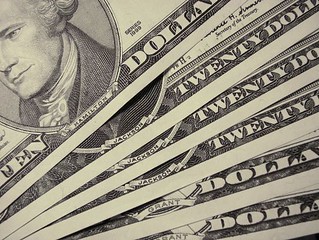 When David Morse leaves his house, he always checks to make sure he has his cell phone and his car keys. One thing he rarely carries in his pocket these days, however, is cash.
When David Morse leaves his house, he always checks to make sure he has his cell phone and his car keys. One thing he rarely carries in his pocket these days, however, is cash.
"It's just so much easier for me to pay for things with my debit card," said Morse, a 35-year-old Rochester resident. "Why add that extra step of going to an ATM every few days to fill up?"
Whether he's buying groceries or a cup of coffee, Morse is one of a growing number of consumers who say they prefer the convenience of cashless transactions.
"The worst part was ending up with all of that pocket change," Morse said. "Coins in my car, on my dresser. ... Managing them and putting them back into my cash flow was a chore. Easier to let all those pennies come out electronically."
In Rochester, like most American cities, the number of businesses that accept credit or debit cards has been steadily rising, but cash is still the single most popular payment method.
Compared to other developed countries, the United States lags behind in the adoption of cashless transactions.
In Sweden, for example, cash is used in less than 2 percent of transactions, according to that country's central bank. Fewer than half of Swedish bank branches keep any cash on hand or accept cash deposits.
Retailers in Denmark are not longer legally required to accept cash payments, and a third of the population uses an app on their mobile phones to pay for goods and services.
"It would make life a lot easier," says Marty O'Sullivan, who owns a barbecue restaurant on Park Avenue in Rochester called Marty's on Park. "I've wanted to go cashless for about three years."
O'Sullivan says there is a cost associated with handling cash that likely exceeds the 3 percent he'd pay in transaction fees. Taking money to and from the bank, ensuring there's enough on hand to make change, and even the act of counting the money takes time.
On top of that, there's concern about theft — either by employees or customers — and there can be loss associated with miscounting change.
"If it's all credit card payments, I really don't have to do anything," he said.
To read the complete article, see:
Do you go cashless? Or do you prefer hard currency?
(http://www.democratandchronicle.com/story/money/2017/07/20/going-cashless-capitalist-society/483819001/)
PANHANDLER’S LAMENT: NO ONE HAS CASH TO GIVE
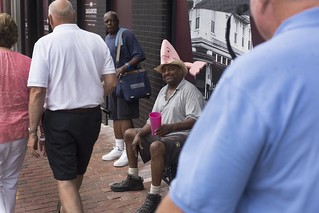 John Sullivan wears a giant foam hat in the shape of a whale. It works well as a conversation starter when he panhandles on the corner of Wisconsin Avenue and M Street in Georgetown. But
one hot afternoon in July, no one stops to ask Sullivan about the whale. And no one stops to drop a dollar in his pink plastic cup.
John Sullivan wears a giant foam hat in the shape of a whale. It works well as a conversation starter when he panhandles on the corner of Wisconsin Avenue and M Street in Georgetown. But
one hot afternoon in July, no one stops to ask Sullivan about the whale. And no one stops to drop a dollar in his pink plastic cup.
Passing by, one young man in sunglasses turns and shrugs. “I don’t have any cash,” he says apologetically.
That’s a refrain Sullivan has heard a lot lately. He has panhandled in the same spot for almost 20 years and has a good rapport with the locals, who call him “the whale man.” But in the past three years or so, more and more pedestrians have been telling him that they no longer carry paper bills or loose change.
Sullivan’s good-natured about it: “I’ll see you next time,” he says with a smile if a passerby claims to have nothing but a credit card. Lots of people actually do come back the next day with change, he says — but still, he takes in only half what he once did.
Orlando Chase, who panhandles on the same corner as Sullivan, isn’t quite as patient as his friend. “They say they got credit cards,” he scoffs. “I gotta eat. I can’t eat with their credit cards. That’s a done deal.”
A decade ago, you probably wouldn’t have thought to go out without at least a crumpled $5 or $10 bill in your pocket. Nowadays, though, you can use credit cards just about anywhere — and a growing number of smartphone apps are letting us swap clumsy cash for simple swipes when paying a cabdriver, tipping a delivery guy or even splitting a tab with a friend.
It’s all very efficient. But for panhandlers and street vendors, all that efficiency just translates into a whole lot less generosity.
Within the next five to 10 years, the United States could become a “less-cash” or “cash-light” society. That’s the prediction of Harvard economist Kenneth S. Rogoff, who envisions a day when physical currency will be phased out of most legal transactions. A recent survey by Ipsos found that 38 percent of U.S. respondents would ditch cash completely if they could, while 34 percent report that they already rarely carry it.
To read the complete article, see:
The panhandler’s lament: In an increasingly cashless world, fewer have a dime to spare
(https://www.washingtonpost.com/lifestyle/style/the-panhandlers-lament-in-an-increasingly-cashless-world-fewer-have-a-dime-to-spare/2017/08/04/03d47068-7154-11e7-8839-ec48ec4cae25_story.html?utm_term=.4d4f48f2a5f2)

